#my monthly forecast notes have a little more detail
Text
Mercury went retrograde and there's a new moon on Friday
0 notes
Text
Bear in mind that each one investment opportunities carry a bound risk. This particularly applies to cryptocurrencies, that are still comparatively young in the monetary markets.
Do I actually have to pay to enroll?No, the sign-up process is free of charge. This makes it stand out from different trading bots. Alternative platforms usually raise for either monthly payments or for a purchasing fee. Cryptosoft only requests a payment of at least $250 to start out trading.
Do you need to be an knowledgeable investor to use the Cryptosoft app?No, the app is suitable for beginners, but we have a tendency to advise to take the time to be told how to use it before putting any investments. We tend to also recommend to start out trading by investing little amounts of cash, sometimes the minimum customary of $250, to reduce your risks of capital loss.
Will Cryptosoft solely invest on Bitcoin?Bitcoin is the most cryptocurrency out there but Cryptosoft additionally offers Bitcoin Cash, Ethereum, Ripple and Litecoin to name a few.

What is the minimum deposit?You'll be able to deposit a minimum of $250 in your account in order to start trading. We suggest to start out by investing this quantity on trading bots, especially for beginners.
How abundant cash can I earn?With the proper investments, users claim to have reached important amounts of cash in brief periods of time. According to the web site, users have reached up to $13,00zero greenbacks in profits inside 24 hours. The earnings could not be as high for everybody, however Cryptosoft claims to own the potential to bring important profits to its users.
How much time do I have to spend on it?The app is structured with an algorithm that automatically suggests you the simplest investments to create. Following the trading strategy with that the app was programmed, the software will suggest the most effective time to open and shut an operation. It's designed to minimise the time you spend on it. You're required to pay not more than 20 minutes on it every day just to watch the investments that the app suggests.
Can you lose cash?Yes, like all trading platforms, there's forever a risk of partial or total loss of capital. Thus, as we tend to already mentioned, we have a tendency to suggest to start by investing relatively tiny amounts of cash if you are inexperienced. Once you are acquainted with how the system works, you'll certainly begin investing additional.
Is Cryptosoft the best crypto robot?It's onerous to say whether it is the simplest one, however there are certainly many scams out there and based mostly on our take a look at, Cryptosoft isn't one in all them. It appears to be a reliable and effective platform with a high claimed success rate.
What is the success rate of Cryptosoft?Cryptosoft claims to achieve success over 85% of the time. This would build Cryptosoft one in every of the most legit trading bots out there.
Is there a demo trading option?No, however you have access to both trading history and trading choices before you deposit your money into your account. This undoubtedly helps you get an idea of what the robot looks like before you invest your cash in it.
Remember, all trading carries risk. Past performance isn't any guarantee of future results.Article InformationAuthor: Patrick WebberLast Updated: 28 July 2020

AvatarA cryptocurrency and trading writer and editor, I concentrate on algorithmic trading. I’ve written concerning each sort of automated trading tools - from cryptocurrency robots, binary option robots, right down to robo advisors. My goal is to jot down honest reviews regarding automated trading tools so as to help users perceive that software are trustworthy and that ones they should keep removed from. I am constantly analysing and scrutinising the up and returning trading apps so if you are seeking advice or if you'd like me to write a robot review in explicit do not hesitate to urge in bit – I’m happy to assist!
FOLLOW ON
May eighteen, 2019 at two:forty pm Hello Potz, it's laborious to predict what you may earn on this platform as it's dependent out there’s performance and therefore the robot’s algorithm along with how you trade. Folks have made tons of bucks inside days on this platform. But, to earn great profits, you need to invest a bigger quantity in the beginning too.
Hello mich2a pair of, we tend to are very happy to hear that you are doing so good on the platform. Cryptosoft is among our most counseled crypto bots and it has helped countless others in generating high returns.
Note that the content on this website should not be thought-about investment recommendation. Investing is speculative. When investing your capital is in danger. This site is not meant for use in jurisdictions in which the trading or investments described are prohibited and should only be used by such persons and in such ways as are legally permitted. Your investment could not qualify for investor protection in your country or state of residence, therefore please conduct your own due diligence. This website is free for you to use however we tend to could receive commission from the companies we feature on this
5 The Verdict! Is it scam? Is it legit?The very first step you will encounter if you form”Cryptosoft” on your search engine is the foremost seemingly to be the official web site. There are plenty of fraudulent sites out there, do not risk putting your arduous earned money in the hands.It is a sensible plan to assist you decide whether or not you wish to utilize Cryptosoft.Thus, what is it?Cryptosoft could be a programmed platform that’s meant to guide users’ investments. The program analyses the sector along with cryptocurrency costs and indicates which investments are secure to make. In case the bot forecasts the price of a cryptocurrency can move up,
it will suggest when its worth rises, investors to purchase it at its value and then sell it. The theory behind it's that the system is supposed to tell you that Bitcoin and different cryptocurrencies to buy and/or sell to assist you earn profit. In other words, the software follows an investment strategy and has the function to interchange a physical trader. The app’s notion is that users may sit whereas the robot transactions for you.In actuality
, it's claimed that consumers, even those that were least experienced want but twenty minutes daily to watch the investments. Just twenty minutes each day can allow you to make significant sums, as recommended by the Cryptosoft system. The software asserts that if users plan to trade manually (that solely additional experienced traders must do), further time will be necessary from the patron on the program to analyse trading signs, history and alternatives and determine lucrative investments.
Robot Rating Properties Trade
card Trade nowHow to put a Trade With Cryptosoft? Will You make Money With Cryptosoft? After you get the Cryptosoft website, you’ll be requested to put in writing your name and email address to get any info about Cryptosoft. one.
The registration procedure is pretty straight and free of charge forward. A few details can be needed from you as an example your name, last name, email address, password and phonephone number.
In your email, you’ll realize a confirmation code once that address. You’ll be requested to insert that code.

Cryptosoft payment choices are various, creating this measure of the process additional straightforward in contrast to systems like Bitcoin Revolution, where the payment options to form deposits are limited. three.
Unfortunately, Cryptosoft doesn’t have demo accounts out there for investors to check the stage. Having it might permit users to watch the Cryptosoft app
But you have got access to alternatives and this trading background to find an concept of what the robot resembles before money gets concerned.
https://www.cryptoerapro.com/cryptosoft/
http://www.cryptoerapro.com/
https://twitter.com/cryptoerapro
https://www.instagram.com/cryptoerapro/
https://www.pinterest.co.uk/cryptoerapro/
https://www.facebook.com/cryptoerapro
1 note
·
View note
Text
Rant: Pop Culture Astrology
If you’re an astrology fanatic like myself, you’ve probably heard or seen comments like this:
“There’s way more than 12 types of people on this planet!”
“I’m a (insert sun sign here) and I’m nothing like it’s description!”
“Astrology is bullshit because I’m a (zodiac sign) and I’m dating a (poorly aspected sign to previous) and we get along great!”
“The stars can’t determine who people are that’s ridiculous”
The list drags on, (comment any other statements you’ve come across). These statements make me want to choke on a fork. Astrology is often looked down upon for being “too generalized”, a common theme in the statements above, but anyone who’s cared to look up what a natal chart is knows it’s not true. Everyone has a birth chart as unique as their thumbprint, and the sun sign is just a tiny part of it. Even twins can have completely different moon and rising signs. Not to mention, there’s draconic charts, synastry charts, composite charts, 9 different persona charts per person, progressions, and soooo much more different charts. It’s also more than just the 12 signs too, there’s houses, angles, aspects, decans, transits, rulership, retrogrades, and more. But fuck all that! These people still really wanna sit here and tell me that astrology is a bunch of made up bullshit. I know it’s a lot for their tiny brains to handle but can you please not devalidate other people’s interests because you’re too ignorant to even try to understand them?! (Damn I gotta calm down lol).
At the same time, I can’t blame people for thinking this way, (my Libra rising ass tryna keep the balance here). There are a lot of pages on Instagram that post generalized posts as their whole feed, and while I don’t have a problem with these posts at all, it is probably why so many people only have a “pop culture” view of the topic. You also see so many horoscope pages give out random weekly, monthly or daily forecasts. But little do most people know, the terms “horoscope” and “birth chart” can be used interchangeably. People are right when they say those daily horoscope things are inaccurate, because in order for it to be accurate, you need to be inputting a birth date, birth time, and birthplace/ coordinates. Also, if you are to look at horoscopes written by astrologers, (not random people on Snapchat), use your rising sign. The rising sign changes about every 2 hours while the sun stays in one sign for about 30 days, so the rising sign will give you a more personalized reading
Another note is that people love to claim that astrology is some made up shit, but may believe in stuff like Harry Potter houses. So many people are against astrology because “it’s generalized into 12 signs” but no one cares that people believe the world can be sorted into 4 groups by a magical hat?? It doesn’t make any sense to me. There are also people who swear by the Myers Briggs test, and while I do find those to be fun and accurate, (ENTP btw lol), why is that not just some “made up shit”? And about the whole “stars can’t define people” thing, that’s true! Astrology doesn’t “lay out your life” in great detail necessarily, (sorry Virgo), but may show you where your natural strengths and weaknesses are, some themes in your life, and stuff like that. But here’s something to think about, if the moon practically controls the oceans tides, which is a massive body of water that covers about 75% of the entire planet, why does it seem so weird to people that the position of the moon affects people, which are also about 75% water? Thanks for reading if you read to the end, and no hard feelings anyone. I hope I informed someone today and provided new insights, and maybe even sparked a new passion in someone for astrology.
2 notes
·
View notes
Text
Fulfill Untapped Customer Demands Through Your Faceted Navigation
Faceted navigation allows customers to narrow down search results based on specific product attributes. They typically exist on Product Listing Pages (PLPs) and are a great way to help users intuitively discover products but managing this filtering system is a common SEO challenge. Crawling and indexation need to be controlled.
However, if we look beyond their inherent functionality, facets can offer us considerable potential. By centering your secondary navigation on long-tail keyword opportunities, you’ll be able to strategically utilize consumer intent, secure additional web conversions, and boost revenue levels.
Match consumer intent with long-tail search queries
Having an established brand and a solid domain backlink profile won’t guarantee success. This is great news for smaller brands, as industry giants aren’t necessarily going to win at this game.
If we search for “long sleeve wedding dresses”, we can see how David’s Bridal’s optimized facet page (Domain Authority: 67/100, Page Authority: 47 / 100) has obtained the top ranking position, while Nordstrom’s result (Domain Authority: 87/100, Page Authority: 39/100) appears in the third position for this particular query. We’ll take a look at what makes this page so effective later.
When looking at how we can optimize faceted navigations, it’s important to recognize that product attributes convey consumer needs and aspirations. If, for example, I’m looking for a wedding dress, then I may tailor my search by the color, fabric, neckline shape, and the sleeve length.
According to the search demand curve, long-tail queries account for up to 70% of all organic searches. They are highly targeted queries that offer big traffic-driving opportunities.
In the last few years, we’ve seen a big shift in the industry towards capitalizing this intent with long-form content. Blog articles and style guides have become the go-to methods for many to capture these visitors, as we can see from the examples taken from Marks & Spencers’ "Inspire Me" section:

People often look for inspiration when they’re shopping, and these pages provide an effective way to add more internal links to category and product pages. But relying on this approach is one-dimensional, given that these deeper content pages tend to have lower PageRank. An extensive amount of time and effort will, therefore, be required to achieve the desired result.
In comparison, Product Listing Pages usually target broader search terms, and faceted navigations typically exist as passive functions. This is because they’re often blocked from crawlers, making them devoid of any SEO value. Waterstones (a well-known British bookstore) is one retailer that applies this rule for their on-page filters:
In this particular example, I’ve applied a filter to only show me books for 5 – 8 year olds, but the appended URL (https://ift.tt/3xrpOJS) is blocked in the robots.txt file. This is going to prevent such pages from being served in the SERPs despite them having the potential to meet specific customer needs. This shows that there can be a fundamental disconnect in matching customer intent to the pages we’re providing them in the organic results.
From the diagram below, we can see how editorial content typically focuses on the “awareness” and “interest” stages, whilst Product Listing Pages tend to be more in line with the “consideration” and “purchase” phases:
Serving the right content to users throughout their buying journey is pivotal to success. For many retailers, competitors are continuing to prioritize broader, high-volume keywords in saturated markets. They’re targeting the same terms to secure a proportion of the same search traffic. This is a very challenging prospect to face, and without carving out a gap in the marketplace, they won’t necessarily deliver the results they seek to secure. Likewise, relying on informational guides to target long-tail keywords means that you’re missing a large percentage of users who have very specific buying requirements. Yes, they’re ready to make a purchase!
By shifting your focus to address your customer’s real needs and expectations, you’ll be able to deliver a satisfying, frictionless experience at every interaction and all the way through to that final purchase.
The solution
Step 1: Conduct long-tail keyword research
Build a really comprehensive view of your potential customers by harnessing data from a variety of sources, including:
a) Keyword research tools like Moz, Google Keyword Planner, and Answer The Public.
b) The SERPs — get inspiration from the auto-suggest results, People Also Ask, and the related search links at the bottom of the page.
c) Competitor activity — aside from using SEO monitoring software, you can use a data mining extension tool like Scraper, which will extract faceted options directly from competitor Product Listing Pages. These tools are often free to download and allow you to quickly transfer product categories.
d) Your Google Search Console, Analytics, and PPC accounts to determine which keywords and URLs are securing the highest number of visits and web conversions. Internal search data can also give you great consumer insights.
e) Speak to your merchandising team to understand product demands and fulfillment capabilities.
Step 2: Group into meaningful sub-topics
Once you’ve collated all this information into a spreadsheet, you’ll be able to discover long-tail, consideration-orientated keywords. While individually they may not boast huge monthly search estimates, they can collectively highlight where purchase intentions can be better fulfilled.
To help illustrate this point, we can look at a small subset of lingerie keywords and the facets the searches represent:

From the table above we can quickly see a pattern emerging with color and material variations appearing across the search terms. We can then substantiate this information with session and revenue estimates with the use of a recognized CTR model. This enables us to help forecast the potential organic uplift and quantify the size of the prize for a number of different scenarios that are on offer from each new facet combination. This may include estimations for securing position 10, 7, 5, 3 and 1 in Google.
One thing to note here is that it’s worth excluding synonyms, as they will falsely inflate your calculations. An example here would be to exclude “storage drawers” (22.2k monthly searchers) when reviewing the performance for “chest of drawers” (201k m/s). Including both variants will cause a false positive result and will lead you to draw incorrect conclusions.
Step 3: Dig deeper into broader terms around offers, ratings, and price
These product filters are found in the “Sort” dropdown box and, from my experience, these are set to “noindex” from the outset as they simply allow users to re-order page results. Certainly, content management systems like Shopify and Shopware have this as a default.
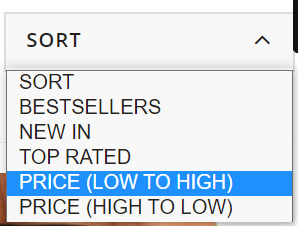
This makes sense since their purpose is to allow visitors to simply sort or narrow page content rather than offering alternative results and additional value (which is offered through faceted navigation). As such, filter typically produce duplicate results which should not be discoverable beyond the immediate moment. But this hard-and-fast rule doesn’t always apply perfectly in the real world. This is why we need to look at our individual industries and understand what’s important to our unique set of customers.
If we look at the world of gifting, we often see people shopping with a particular budget in mind. Therefore, terms like “birthday gift under £20” (40 m/s) or “Secret Santa gift under £10” (2.9k m/s) are reasonably common, and opening up relevant listing pages could be useful for shoppers.
Step 4: The technical steps
Facet taxonomies are hugely complex and the number of attributes that can be strung together increases with the size of the domain. We, therefore, need to carefully manage the flood gates and mitigate against any potential risks including crawl inefficiencies and link equity dilution.
We can do this by:
1. Avoiding thin/doorway pages by regularly re-assessing your product offering. For instance, you may consider there to be little value in creating a new listings page if you’re selling a very small range of low price point products. In this case, you may decide against opening up an additional Product Listing Page when you sell as few as 10 eligible products. However, this is not a fixed rule, so it’s quite possible that your criteria may be lower for particular product lines. Either way, these numbers will change over time. Consider seasonal trends, when new collections are launched, and when they become discontinued. Setting up a product retirement strategy to manage expired products and categories at scale in parallel with this step is also highly recommended.
2. Prevent content cannibalization by arranging selected facets according to their value and significance. “Size” is very important for some electrical goods like TVs, laptops, and cameras, but is less so for beauty accessories or vacuum cleaners. You must also make sure page content is distinctive and reflects the focus of your chosen facet(s). Refer to step 5 for more details.
3. Follow the sequence in which adjectives and facets are typically selected by your customers. This can vary depending on where your audience lives. So, whilst products generally have five or more distinguishable features, English vernacular determines that we use more than four adjectives (e.g. size + color + material + shape) to describe something.
4. Control the controllables by dealing with overlapping variations. This typically occurs when multiples co-exist and each exhibits good search metrics. For instance, it’s reasonable for someone to simultaneously look for several color and/or fabric combinations in the different ways below.
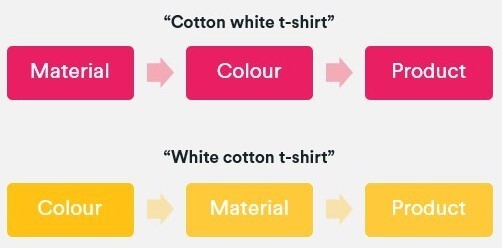
When this situation occurs, we should follow the same linguistic rules as above and choose a preferred sequence. In this case, it would be color + material + product type.
In comparison to the noindex tag suggested for on-page filters you should canonicalize unnecessary facets to their parent page (remembering that this is merely a hint and not a directive). This will enable you to control how crawlers deal with highly comparable result pages and will, therefore, help to prevent your site from being demoted in the SERPs. Dynamic search parameters should continue to be defined with a “noindex, nofollow” meta robots tag, disallowed in the robots.txt file, and configured through Google’s URL parameter tool (within your Search Console account) to tell crawlers the purpose of your parameters and how you would like them to be treated. This is a helpful guide on parameter handling for Googlebots, but bear in mind that this last tip won’t influence how Bing or Yahoo user-agents interpret these pages.
5. Open your facets in phases and cultivate it into a test-and-learn process. This will enable you to identify issues a lot sooner and implement facet-wide solutions in a timely manner. Without having to unravel these additional layers of complexity, problems such as crawl inefficiencies, PageRank dilution, or excessive indexation can be swiftly resolved.
To show you what this could look like, I’ve provided a phasing plan that was created for one of our e-commerce clients. Our research showed a significant SEO opportunity for opening up some of the facets and filters: potential +£263Kpcm for the “colour + type” facet (UK):
What’s more, when we extended our forecast to include other facet combinations, we calculated an additional revenue opportunity of up to +£207K/pcm (before filtering out combinations with no products offering).
Step 5: Optimize your facet URLs
Optimize your new facet category URLs to establish relevancy for your selected search terms. The key on-page elements to focus on include:
URL
Page title
Breadcrumb anchor texts
H tags
Content snippets (e.g. introductory text and FAQ copy)
Image ALT texts
Product names
Link out to similar facet category pages (i.e. via a “You May Also Like” feature box)
David’s Bridal is a good example of a retailer that has done this well. Looking back at the ‘Long Sleeve Wedding Dress’ Product Listing Page, we can see that they’ve curated unique content and followed fundamental optimization tactics on the landing page in a way that feels helpful to the user.
URL: davidsbridal.com/long-sleeve-wedding-dresses
Page Title: Long Sleeve Wedding Dresses & Gowns | David's Bridal
Meta Description: Do you dream of wearing a long sleeve wedding dress on your big day? Shop David's Bridal wide variety of wedding gowns with sleeves in lace & other designs!
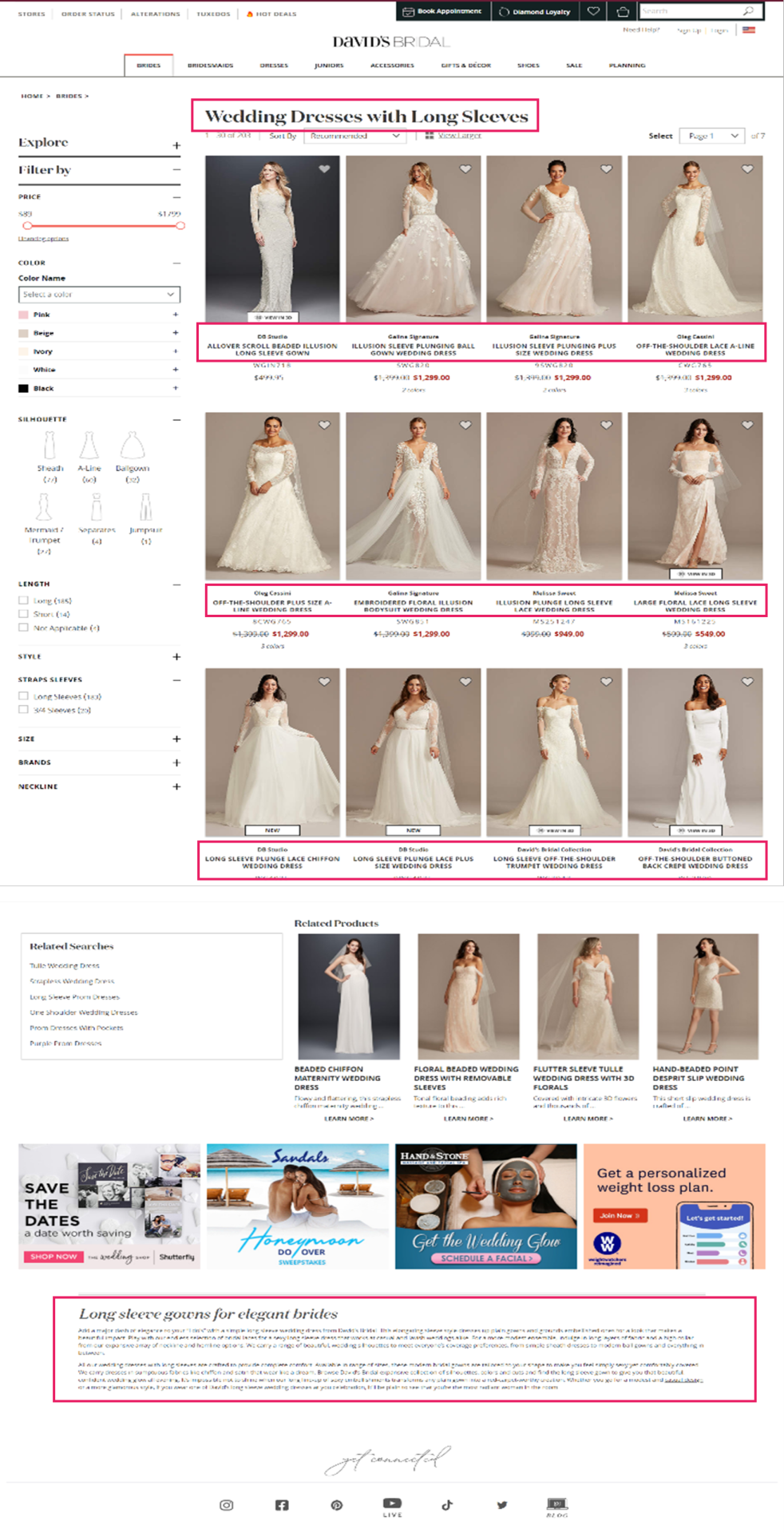
6. Provide accessibility and build page authority
Once you’ve opened up your new facet Product Listing Pages, you need to begin cultivating link equity towards them. This will ensure that they don’t exist as orphan URLs with no PageRank:
Ensure they’re referenced in your product XML sitemap.
If you have one feature per facet URL, then add them to your faceted navigation across CLP and Product Listing Page pages.
If you have two or more features per facet URL, then create a “Popular Searches” or “Related Searches” option within your CLPs.
Utilize your mega menu to showcase your new category landing pages. This will not only allow you to direct a large proportion of link equity, but it will also secure the highest click-through rate amongst your visitors.
Integrate your editorial strategy by creating engaging content with in-copy links. Think about how you can use descriptive long-tail anchor text about the Product Listing Page you want to link to rather than relying on “click here” or “see more”.
Connect to them via href links so you’re not solely relying on links from the main navigation or content hyperlinks. As this is difficult to do at scale, it can be done through modules such as “related categories”, “other subcategories”, “related products”, etc.
Devise strategic outreach campaigns that will secure quality, external backlinks to them.
Implementing this holistic and robust strategy will help you to secure exponential growth from your new commercial landing pages.
Conclusion
There is a great deal of organic opportunity that exists within your faceted navigation if you begin to leverage mid- and long-tail search terms.
Seek out the opportunity from extended keyword research and competitor analysis before deciding which variants fulfill consumer demands and deliver optimal organic sessions and onsite conversions. Configure a single faceted URL for each opportunity and open them up for crawl and indexation. Ensure PageRank is distributed to them (both internally and externally) and develop your landing page content in line with quality optimization practices. This approach will help you to avoid having crawl inefficiencies, over indexation, cannibalization, or having thin doorway pages. In turn, your website will be better suited to attract highly-targeted users and guide them down the purchase funnel.
Maximizing UX and reducing reliance on other marketing channels means that your faceted navigation can truly deliver organic ROI. We have seen this work for our clients.
0 notes
Text
Fulfill Untapped Customer Demands Through Your Faceted Navigation
Faceted navigation allows customers to narrow down search results based on specific product attributes. They typically exist on Product Listing Pages (PLPs) and are a great way to help users intuitively discover products but managing this filtering system is a common SEO challenge. Crawling and indexation need to be controlled.
However, if we look beyond their inherent functionality, facets can offer us considerable potential. By centering your secondary navigation on long-tail keyword opportunities, you’ll be able to strategically utilize consumer intent, secure additional web conversions, and boost revenue levels.
Match consumer intent with long-tail search queries
Having an established brand and a solid domain backlink profile won’t guarantee success. This is great news for smaller brands, as industry giants aren’t necessarily going to win at this game.
If we search for “long sleeve wedding dresses”, we can see how David’s Bridal’s optimized facet page (Domain Authority: 67/100, Page Authority: 47 / 100) has obtained the top ranking position, while Nordstrom’s result (Domain Authority: 87/100, Page Authority: 39/100) appears in the third position for this particular query. We’ll take a look at what makes this page so effective later.
When looking at how we can optimize faceted navigations, it’s important to recognize that product attributes convey consumer needs and aspirations. If, for example, I’m looking for a wedding dress, then I may tailor my search by the color, fabric, neckline shape, and the sleeve length.
According to the search demand curve, long-tail queries account for up to 70% of all organic searches. They are highly targeted queries that offer big traffic-driving opportunities.
In the last few years, we’ve seen a big shift in the industry towards capitalizing this intent with long-form content. Blog articles and style guides have become the go-to methods for many to capture these visitors, as we can see from the examples taken from Marks & Spencers’ "Inspire Me" section:

People often look for inspiration when they’re shopping, and these pages provide an effective way to add more internal links to category and product pages. But relying on this approach is one-dimensional, given that these deeper content pages tend to have lower PageRank. An extensive amount of time and effort will, therefore, be required to achieve the desired result.
In comparison, Product Listing Pages usually target broader search terms, and faceted navigations typically exist as passive functions. This is because they’re often blocked from crawlers, making them devoid of any SEO value. Waterstones (a well-known British bookstore) is one retailer that applies this rule for their on-page filters:
In this particular example, I’ve applied a filter to only show me books for 5 – 8 year olds, but the appended URL (https://ift.tt/3xrpOJS) is blocked in the robots.txt file. This is going to prevent such pages from being served in the SERPs despite them having the potential to meet specific customer needs. This shows that there can be a fundamental disconnect in matching customer intent to the pages we’re providing them in the organic results.
From the diagram below, we can see how editorial content typically focuses on the “awareness” and “interest” stages, whilst Product Listing Pages tend to be more in line with the “consideration” and “purchase” phases:
Serving the right content to users throughout their buying journey is pivotal to success. For many retailers, competitors are continuing to prioritize broader, high-volume keywords in saturated markets. They’re targeting the same terms to secure a proportion of the same search traffic. This is a very challenging prospect to face, and without carving out a gap in the marketplace, they won’t necessarily deliver the results they seek to secure. Likewise, relying on informational guides to target long-tail keywords means that you’re missing a large percentage of users who have very specific buying requirements. Yes, they’re ready to make a purchase!
By shifting your focus to address your customer’s real needs and expectations, you’ll be able to deliver a satisfying, frictionless experience at every interaction and all the way through to that final purchase.
The solution
Step 1: Conduct long-tail keyword research
Build a really comprehensive view of your potential customers by harnessing data from a variety of sources, including:
a) Keyword research tools like Moz, Google Keyword Planner, and Answer The Public.
b) The SERPs — get inspiration from the auto-suggest results, People Also Ask, and the related search links at the bottom of the page.
c) Competitor activity — aside from using SEO monitoring software, you can use a data mining extension tool like Scraper, which will extract faceted options directly from competitor Product Listing Pages. These tools are often free to download and allow you to quickly transfer product categories.
d) Your Google Search Console, Analytics, and PPC accounts to determine which keywords and URLs are securing the highest number of visits and web conversions. Internal search data can also give you great consumer insights.
e) Speak to your merchandising team to understand product demands and fulfillment capabilities.
Step 2: Group into meaningful sub-topics
Once you’ve collated all this information into a spreadsheet, you’ll be able to discover long-tail, consideration-orientated keywords. While individually they may not boast huge monthly search estimates, they can collectively highlight where purchase intentions can be better fulfilled.
To help illustrate this point, we can look at a small subset of lingerie keywords and the facets the searches represent:
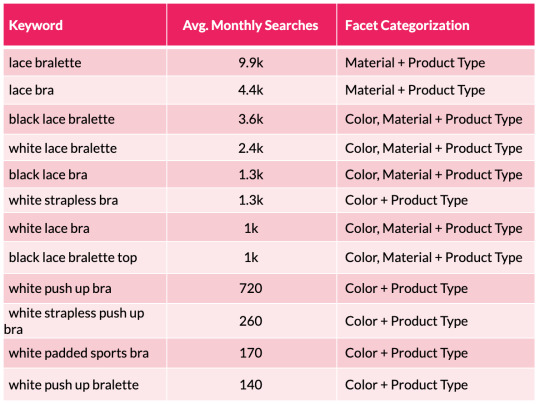
From the table above we can quickly see a pattern emerging with color and material variations appearing across the search terms. We can then substantiate this information with session and revenue estimates with the use of a recognized CTR model. This enables us to help forecast the potential organic uplift and quantify the size of the prize for a number of different scenarios that are on offer from each new facet combination. This may include estimations for securing position 10, 7, 5, 3 and 1 in Google.
One thing to note here is that it’s worth excluding synonyms, as they will falsely inflate your calculations. An example here would be to exclude “storage drawers” (22.2k monthly searchers) when reviewing the performance for “chest of drawers” (201k m/s). Including both variants will cause a false positive result and will lead you to draw incorrect conclusions.
Step 3: Dig deeper into broader terms around offers, ratings, and price
These product filters are found in the “Sort” dropdown box and, from my experience, these are set to “noindex” from the outset as they simply allow users to re-order page results. Certainly, content management systems like Shopify and Shopware have this as a default.
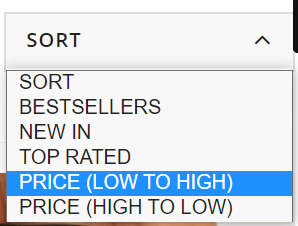
This makes sense since their purpose is to allow visitors to simply sort or narrow page content rather than offering alternative results and additional value (which is offered through faceted navigation). As such, filter typically produce duplicate results which should not be discoverable beyond the immediate moment. But this hard-and-fast rule doesn’t always apply perfectly in the real world. This is why we need to look at our individual industries and understand what’s important to our unique set of customers.
If we look at the world of gifting, we often see people shopping with a particular budget in mind. Therefore, terms like “birthday gift under £20” (40 m/s) or “Secret Santa gift under £10” (2.9k m/s) are reasonably common, and opening up relevant listing pages could be useful for shoppers.
Step 4: The technical steps
Facet taxonomies are hugely complex and the number of attributes that can be strung together increases with the size of the domain. We, therefore, need to carefully manage the flood gates and mitigate against any potential risks including crawl inefficiencies and link equity dilution.
We can do this by:
1. Avoiding thin/doorway pages by regularly re-assessing your product offering. For instance, you may consider there to be little value in creating a new listings page if you’re selling a very small range of low price point products. In this case, you may decide against opening up an additional Product Listing Page when you sell as few as 10 eligible products. However, this is not a fixed rule, so it’s quite possible that your criteria may be lower for particular product lines. Either way, these numbers will change over time. Consider seasonal trends, when new collections are launched, and when they become discontinued. Setting up a product retirement strategy to manage expired products and categories at scale in parallel with this step is also highly recommended.
2. Prevent content cannibalization by arranging selected facets according to their value and significance. “Size” is very important for some electrical goods like TVs, laptops, and cameras, but is less so for beauty accessories or vacuum cleaners. You must also make sure page content is distinctive and reflects the focus of your chosen facet(s). Refer to step 5 for more details.
3. Follow the sequence in which adjectives and facets are typically selected by your customers. This can vary depending on where your audience lives. So, whilst products generally have five or more distinguishable features, English vernacular determines that we use more than four adjectives (e.g. size + color + material + shape) to describe something.
4. Control the controllables by dealing with overlapping variations. This typically occurs when multiples co-exist and each exhibits good search metrics. For instance, it’s reasonable for someone to simultaneously look for several color and/or fabric combinations in the different ways below.

When this situation occurs, we should follow the same linguistic rules as above and choose a preferred sequence. In this case, it would be color + material + product type.
In comparison to the noindex tag suggested for on-page filters you should canonicalize unnecessary facets to their parent page (remembering that this is merely a hint and not a directive). This will enable you to control how crawlers deal with highly comparable result pages and will, therefore, help to prevent your site from being demoted in the SERPs. Dynamic search parameters should continue to be defined with a “noindex, nofollow” meta robots tag, disallowed in the robots.txt file, and configured through Google’s URL parameter tool (within your Search Console account) to tell crawlers the purpose of your parameters and how you would like them to be treated. This is a helpful guide on parameter handling for Googlebots, but bear in mind that this last tip won’t influence how Bing or Yahoo user-agents interpret these pages.
5. Open your facets in phases and cultivate it into a test-and-learn process. This will enable you to identify issues a lot sooner and implement facet-wide solutions in a timely manner. Without having to unravel these additional layers of complexity, problems such as crawl inefficiencies, PageRank dilution, or excessive indexation can be swiftly resolved.
To show you what this could look like, I’ve provided a phasing plan that was created for one of our e-commerce clients. Our research showed a significant SEO opportunity for opening up some of the facets and filters: potential +£263Kpcm for the “colour + type” facet (UK):
What’s more, when we extended our forecast to include other facet combinations, we calculated an additional revenue opportunity of up to +£207K/pcm (before filtering out combinations with no products offering).
Step 5: Optimize your facet URLs
Optimize your new facet category URLs to establish relevancy for your selected search terms. The key on-page elements to focus on include:
URL
Page title
Breadcrumb anchor texts
H tags
Content snippets (e.g. introductory text and FAQ copy)
Image ALT texts
Product names
Link out to similar facet category pages (i.e. via a “You May Also Like” feature box)
David’s Bridal is a good example of a retailer that has done this well. Looking back at the ‘Long Sleeve Wedding Dress’ Product Listing Page, we can see that they’ve curated unique content and followed fundamental optimization tactics on the landing page in a way that feels helpful to the user.
URL: davidsbridal.com/long-sleeve-wedding-dresses
Page Title: Long Sleeve Wedding Dresses & Gowns | David's Bridal
Meta Description: Do you dream of wearing a long sleeve wedding dress on your big day? Shop David's Bridal wide variety of wedding gowns with sleeves in lace & other designs!
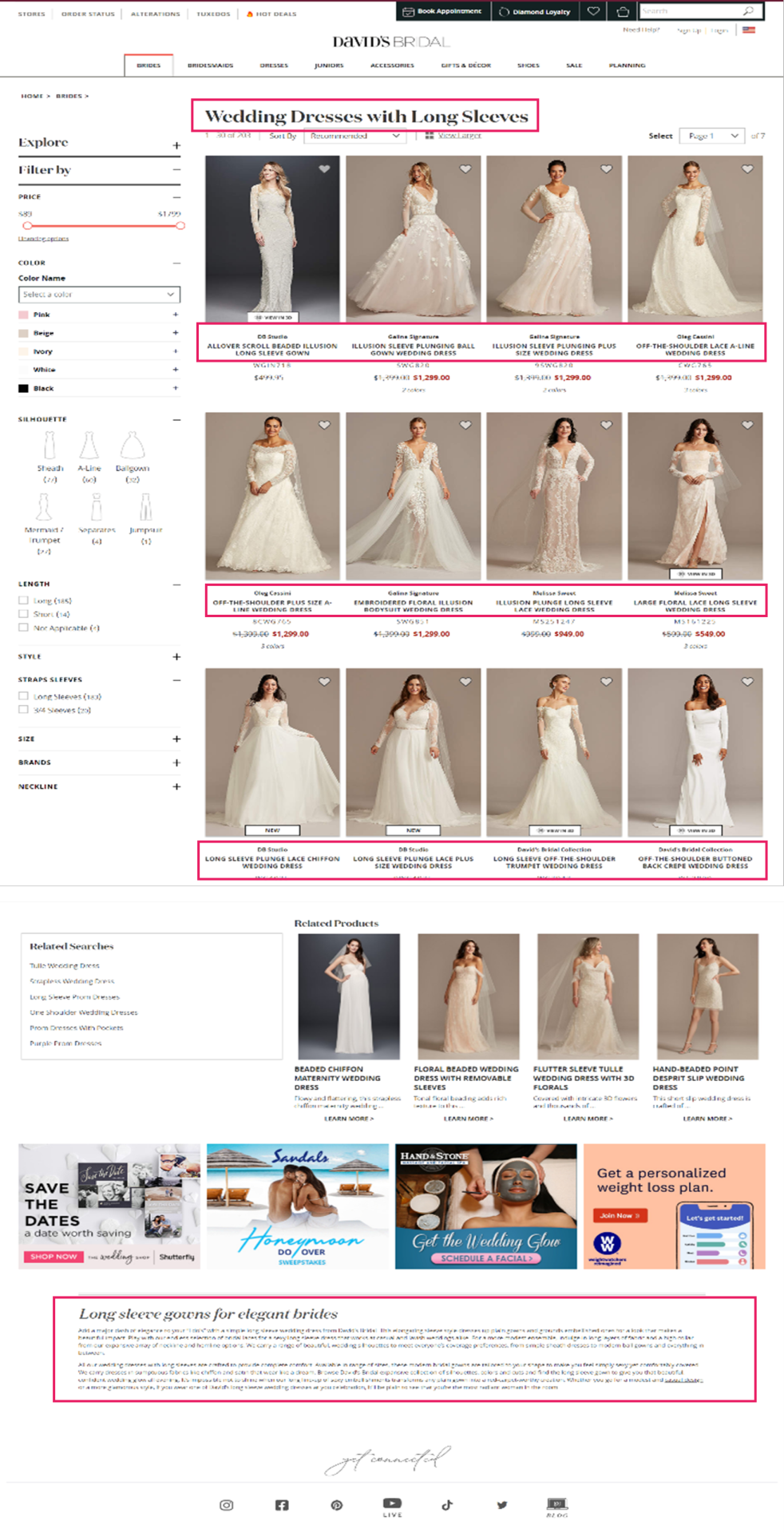
6. Provide accessibility and build page authority
Once you’ve opened up your new facet Product Listing Pages, you need to begin cultivating link equity towards them. This will ensure that they don’t exist as orphan URLs with no PageRank:
Ensure they’re referenced in your product XML sitemap.
If you have one feature per facet URL, then add them to your faceted navigation across CLP and Product Listing Page pages.
If you have two or more features per facet URL, then create a “Popular Searches” or “Related Searches” option within your CLPs.
Utilize your mega menu to showcase your new category landing pages. This will not only allow you to direct a large proportion of link equity, but it will also secure the highest click-through rate amongst your visitors.
Integrate your editorial strategy by creating engaging content with in-copy links. Think about how you can use descriptive long-tail anchor text about the Product Listing Page you want to link to rather than relying on “click here” or “see more”.
Connect to them via href links so you’re not solely relying on links from the main navigation or content hyperlinks. As this is difficult to do at scale, it can be done through modules such as “related categories”, “other subcategories”, “related products”, etc.
Devise strategic outreach campaigns that will secure quality, external backlinks to them.
Implementing this holistic and robust strategy will help you to secure exponential growth from your new commercial landing pages.
Conclusion
There is a great deal of organic opportunity that exists within your faceted navigation if you begin to leverage mid- and long-tail search terms.
Seek out the opportunity from extended keyword research and competitor analysis before deciding which variants fulfill consumer demands and deliver optimal organic sessions and onsite conversions. Configure a single faceted URL for each opportunity and open them up for crawl and indexation. Ensure PageRank is distributed to them (both internally and externally) and develop your landing page content in line with quality optimization practices. This approach will help you to avoid having crawl inefficiencies, over indexation, cannibalization, or having thin doorway pages. In turn, your website will be better suited to attract highly-targeted users and guide them down the purchase funnel.
Maximizing UX and reducing reliance on other marketing channels means that your faceted navigation can truly deliver organic ROI. We have seen this work for our clients.
0 notes
Text
Fulfill Untapped Customer Demands Through Your Faceted Navigation
Faceted navigation allows customers to narrow down search results based on specific product attributes. They typically exist on Product Listing Pages (PLPs) and are a great way to help users intuitively discover products but managing this filtering system is a common SEO challenge. Crawling and indexation need to be controlled.
However, if we look beyond their inherent functionality, facets can offer us considerable potential. By centering your secondary navigation on long-tail keyword opportunities, you’ll be able to strategically utilize consumer intent, secure additional web conversions, and boost revenue levels.
Match consumer intent with long-tail search queries
Having an established brand and a solid domain backlink profile won’t guarantee success. This is great news for smaller brands, as industry giants aren’t necessarily going to win at this game.
If we search for “long sleeve wedding dresses”, we can see how David’s Bridal’s optimized facet page (Domain Authority: 67/100, Page Authority: 47 / 100) has obtained the top ranking position, while Nordstrom’s result (Domain Authority: 87/100, Page Authority: 39/100) appears in the third position for this particular query. We’ll take a look at what makes this page so effective later.
When looking at how we can optimize faceted navigations, it’s important to recognize that product attributes convey consumer needs and aspirations. If, for example, I’m looking for a wedding dress, then I may tailor my search by the color, fabric, neckline shape, and the sleeve length.
According to the search demand curve, long-tail queries account for up to 70% of all organic searches. They are highly targeted queries that offer big traffic-driving opportunities.
In the last few years, we’ve seen a big shift in the industry towards capitalizing this intent with long-form content. Blog articles and style guides have become the go-to methods for many to capture these visitors, as we can see from the examples taken from Marks & Spencers’ "Inspire Me" section:

People often look for inspiration when they’re shopping, and these pages provide an effective way to add more internal links to category and product pages. But relying on this approach is one-dimensional, given that these deeper content pages tend to have lower PageRank. An extensive amount of time and effort will, therefore, be required to achieve the desired result.
In comparison, Product Listing Pages usually target broader search terms, and faceted navigations typically exist as passive functions. This is because they’re often blocked from crawlers, making them devoid of any SEO value. Waterstones (a well-known British bookstore) is one retailer that applies this rule for their on-page filters:
In this particular example, I’ve applied a filter to only show me books for 5 – 8 year olds, but the appended URL (https://ift.tt/3xrpOJS) is blocked in the robots.txt file. This is going to prevent such pages from being served in the SERPs despite them having the potential to meet specific customer needs. This shows that there can be a fundamental disconnect in matching customer intent to the pages we’re providing them in the organic results.
From the diagram below, we can see how editorial content typically focuses on the “awareness” and “interest” stages, whilst Product Listing Pages tend to be more in line with the “consideration” and “purchase” phases:
Serving the right content to users throughout their buying journey is pivotal to success. For many retailers, competitors are continuing to prioritize broader, high-volume keywords in saturated markets. They’re targeting the same terms to secure a proportion of the same search traffic. This is a very challenging prospect to face, and without carving out a gap in the marketplace, they won’t necessarily deliver the results they seek to secure. Likewise, relying on informational guides to target long-tail keywords means that you’re missing a large percentage of users who have very specific buying requirements. Yes, they’re ready to make a purchase!
By shifting your focus to address your customer’s real needs and expectations, you’ll be able to deliver a satisfying, frictionless experience at every interaction and all the way through to that final purchase.
The solution
Step 1: Conduct long-tail keyword research
Build a really comprehensive view of your potential customers by harnessing data from a variety of sources, including:
a) Keyword research tools like Moz, Google Keyword Planner, and Answer The Public.
b) The SERPs — get inspiration from the auto-suggest results, People Also Ask, and the related search links at the bottom of the page.
c) Competitor activity — aside from using SEO monitoring software, you can use a data mining extension tool like Scraper, which will extract faceted options directly from competitor Product Listing Pages. These tools are often free to download and allow you to quickly transfer product categories.
d) Your Google Search Console, Analytics, and PPC accounts to determine which keywords and URLs are securing the highest number of visits and web conversions. Internal search data can also give you great consumer insights.
e) Speak to your merchandising team to understand product demands and fulfillment capabilities.
Step 2: Group into meaningful sub-topics
Once you’ve collated all this information into a spreadsheet, you’ll be able to discover long-tail, consideration-orientated keywords. While individually they may not boast huge monthly search estimates, they can collectively highlight where purchase intentions can be better fulfilled.
To help illustrate this point, we can look at a small subset of lingerie keywords and the facets the searches represent:

From the table above we can quickly see a pattern emerging with color and material variations appearing across the search terms. We can then substantiate this information with session and revenue estimates with the use of a recognized CTR model. This enables us to help forecast the potential organic uplift and quantify the size of the prize for a number of different scenarios that are on offer from each new facet combination. This may include estimations for securing position 10, 7, 5, 3 and 1 in Google.
One thing to note here is that it’s worth excluding synonyms, as they will falsely inflate your calculations. An example here would be to exclude “storage drawers” (22.2k monthly searchers) when reviewing the performance for “chest of drawers” (201k m/s). Including both variants will cause a false positive result and will lead you to draw incorrect conclusions.
Step 3: Dig deeper into broader terms around offers, ratings, and price
These product filters are found in the “Sort” dropdown box and, from my experience, these are set to “noindex” from the outset as they simply allow users to re-order page results. Certainly, content management systems like Shopify and Shopware have this as a default.
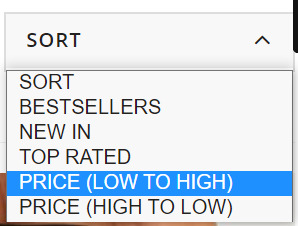
This makes sense since their purpose is to allow visitors to simply sort or narrow page content rather than offering alternative results and additional value (which is offered through faceted navigation). As such, filter typically produce duplicate results which should not be discoverable beyond the immediate moment. But this hard-and-fast rule doesn’t always apply perfectly in the real world. This is why we need to look at our individual industries and understand what’s important to our unique set of customers.
If we look at the world of gifting, we often see people shopping with a particular budget in mind. Therefore, terms like “birthday gift under £20” (40 m/s) or “Secret Santa gift under £10” (2.9k m/s) are reasonably common, and opening up relevant listing pages could be useful for shoppers.
Step 4: The technical steps
Facet taxonomies are hugely complex and the number of attributes that can be strung together increases with the size of the domain. We, therefore, need to carefully manage the flood gates and mitigate against any potential risks including crawl inefficiencies and link equity dilution.
We can do this by:
1. Avoiding thin/doorway pages by regularly re-assessing your product offering. For instance, you may consider there to be little value in creating a new listings page if you’re selling a very small range of low price point products. In this case, you may decide against opening up an additional Product Listing Page when you sell as few as 10 eligible products. However, this is not a fixed rule, so it’s quite possible that your criteria may be lower for particular product lines. Either way, these numbers will change over time. Consider seasonal trends, when new collections are launched, and when they become discontinued. Setting up a product retirement strategy to manage expired products and categories at scale in parallel with this step is also highly recommended.
2. Prevent content cannibalization by arranging selected facets according to their value and significance. “Size” is very important for some electrical goods like TVs, laptops, and cameras, but is less so for beauty accessories or vacuum cleaners. You must also make sure page content is distinctive and reflects the focus of your chosen facet(s). Refer to step 5 for more details.
3. Follow the sequence in which adjectives and facets are typically selected by your customers. This can vary depending on where your audience lives. So, whilst products generally have five or more distinguishable features, English vernacular determines that we use more than four adjectives (e.g. size + color + material + shape) to describe something.
4. Control the controllables by dealing with overlapping variations. This typically occurs when multiples co-exist and each exhibits good search metrics. For instance, it’s reasonable for someone to simultaneously look for several color and/or fabric combinations in the different ways below.

When this situation occurs, we should follow the same linguistic rules as above and choose a preferred sequence. In this case, it would be color + material + product type.
In comparison to the noindex tag suggested for on-page filters you should canonicalize unnecessary facets to their parent page (remembering that this is merely a hint and not a directive). This will enable you to control how crawlers deal with highly comparable result pages and will, therefore, help to prevent your site from being demoted in the SERPs. Dynamic search parameters should continue to be defined with a “noindex, nofollow” meta robots tag, disallowed in the robots.txt file, and configured through Google’s URL parameter tool (within your Search Console account) to tell crawlers the purpose of your parameters and how you would like them to be treated. This is a helpful guide on parameter handling for Googlebots, but bear in mind that this last tip won’t influence how Bing or Yahoo user-agents interpret these pages.
5. Open your facets in phases and cultivate it into a test-and-learn process. This will enable you to identify issues a lot sooner and implement facet-wide solutions in a timely manner. Without having to unravel these additional layers of complexity, problems such as crawl inefficiencies, PageRank dilution, or excessive indexation can be swiftly resolved.
To show you what this could look like, I’ve provided a phasing plan that was created for one of our e-commerce clients. Our research showed a significant SEO opportunity for opening up some of the facets and filters: potential +£263Kpcm for the “colour + type” facet (UK):
What’s more, when we extended our forecast to include other facet combinations, we calculated an additional revenue opportunity of up to +£207K/pcm (before filtering out combinations with no products offering).
Step 5: Optimize your facet URLs
Optimize your new facet category URLs to establish relevancy for your selected search terms. The key on-page elements to focus on include:
URL
Page title
Breadcrumb anchor texts
H tags
Content snippets (e.g. introductory text and FAQ copy)
Image ALT texts
Product names
Link out to similar facet category pages (i.e. via a “You May Also Like” feature box)
David’s Bridal is a good example of a retailer that has done this well. Looking back at the ‘Long Sleeve Wedding Dress’ Product Listing Page, we can see that they’ve curated unique content and followed fundamental optimization tactics on the landing page in a way that feels helpful to the user.
URL: davidsbridal.com/long-sleeve-wedding-dresses
Page Title: Long Sleeve Wedding Dresses & Gowns | David's Bridal
Meta Description: Do you dream of wearing a long sleeve wedding dress on your big day? Shop David's Bridal wide variety of wedding gowns with sleeves in lace & other designs!
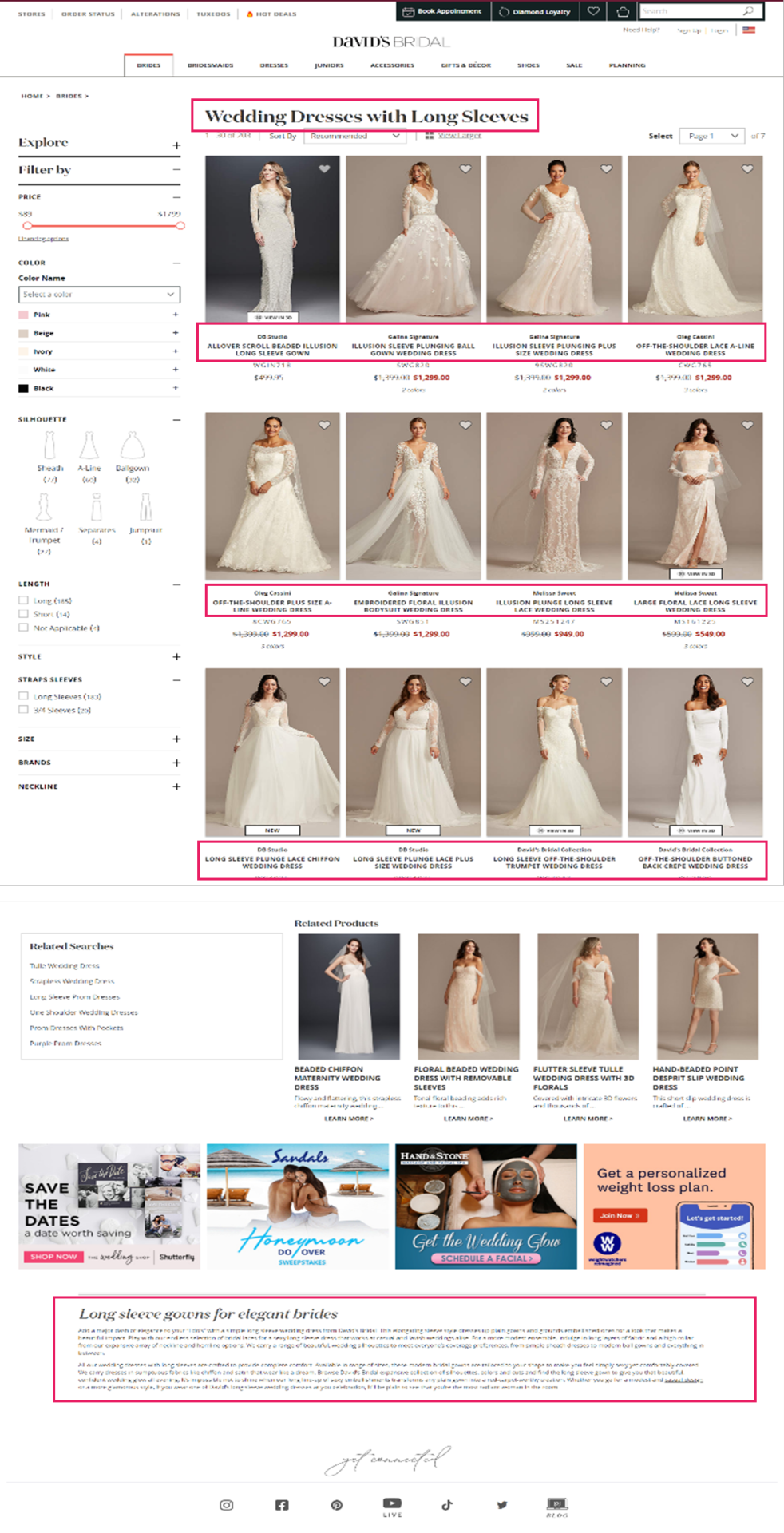
6. Provide accessibility and build page authority
Once you’ve opened up your new facet Product Listing Pages, you need to begin cultivating link equity towards them. This will ensure that they don’t exist as orphan URLs with no PageRank:
Ensure they’re referenced in your product XML sitemap.
If you have one feature per facet URL, then add them to your faceted navigation across CLP and Product Listing Page pages.
If you have two or more features per facet URL, then create a “Popular Searches” or “Related Searches” option within your CLPs.
Utilize your mega menu to showcase your new category landing pages. This will not only allow you to direct a large proportion of link equity, but it will also secure the highest click-through rate amongst your visitors.
Integrate your editorial strategy by creating engaging content with in-copy links. Think about how you can use descriptive long-tail anchor text about the Product Listing Page you want to link to rather than relying on “click here” or “see more”.
Connect to them via href links so you’re not solely relying on links from the main navigation or content hyperlinks. As this is difficult to do at scale, it can be done through modules such as “related categories”, “other subcategories”, “related products”, etc.
Devise strategic outreach campaigns that will secure quality, external backlinks to them.
Implementing this holistic and robust strategy will help you to secure exponential growth from your new commercial landing pages.
Conclusion
There is a great deal of organic opportunity that exists within your faceted navigation if you begin to leverage mid- and long-tail search terms.
Seek out the opportunity from extended keyword research and competitor analysis before deciding which variants fulfill consumer demands and deliver optimal organic sessions and onsite conversions. Configure a single faceted URL for each opportunity and open them up for crawl and indexation. Ensure PageRank is distributed to them (both internally and externally) and develop your landing page content in line with quality optimization practices. This approach will help you to avoid having crawl inefficiencies, over indexation, cannibalization, or having thin doorway pages. In turn, your website will be better suited to attract highly-targeted users and guide them down the purchase funnel.
Maximizing UX and reducing reliance on other marketing channels means that your faceted navigation can truly deliver organic ROI. We have seen this work for our clients.
#túi_giấy_epacking_việt_nam #túi_giấy_epacking #in_túi_giấy_giá_rẻ #in_túi_giấy #epackingvietnam #tuigiayepacking
0 notes
Text
Fulfill Untapped Customer Demands Through Your Faceted Navigation
Faceted navigation allows customers to narrow down search results based on specific product attributes. They typically exist on Product Listing Pages (PLPs) and are a great way to help users intuitively discover products but managing this filtering system is a common SEO challenge. Crawling and indexation need to be controlled.
However, if we look beyond their inherent functionality, facets can offer us considerable potential. By centering your secondary navigation on long-tail keyword opportunities, you’ll be able to strategically utilize consumer intent, secure additional web conversions, and boost revenue levels.
Match consumer intent with long-tail search queries
Having an established brand and a solid domain backlink profile won’t guarantee success. This is great news for smaller brands, as industry giants aren’t necessarily going to win at this game.
If we search for “long sleeve wedding dresses”, we can see how David’s Bridal’s optimized facet page (Domain Authority: 67/100, Page Authority: 47 / 100) has obtained the top ranking position, while Nordstrom’s result (Domain Authority: 87/100, Page Authority: 39/100) appears in the third position for this particular query. We’ll take a look at what makes this page so effective later.
When looking at how we can optimize faceted navigations, it’s important to recognize that product attributes convey consumer needs and aspirations. If, for example, I’m looking for a wedding dress, then I may tailor my search by the color, fabric, neckline shape, and the sleeve length.
According to the search demand curve, long-tail queries account for up to 70% of all organic searches. They are highly targeted queries that offer big traffic-driving opportunities.
In the last few years, we’ve seen a big shift in the industry towards capitalizing this intent with long-form content. Blog articles and style guides have become the go-to methods for many to capture these visitors, as we can see from the examples taken from Marks & Spencers’ "Inspire Me" section:
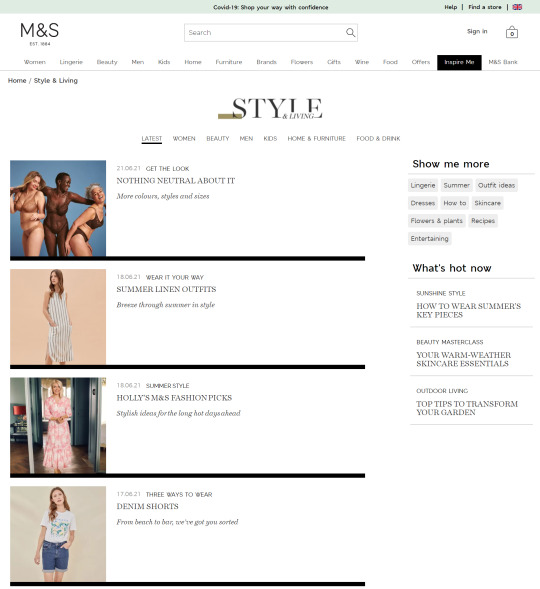
People often look for inspiration when they’re shopping, and these pages provide an effective way to add more internal links to category and product pages. But relying on this approach is one-dimensional, given that these deeper content pages tend to have lower PageRank. An extensive amount of time and effort will, therefore, be required to achieve the desired result.
In comparison, Product Listing Pages usually target broader search terms, and faceted navigations typically exist as passive functions. This is because they’re often blocked from crawlers, making them devoid of any SEO value. Waterstones (a well-known British bookstore) is one retailer that applies this rule for their on-page filters:
In this particular example, I’ve applied a filter to only show me books for 5 – 8 year olds, but the appended URL (https://www.waterstones.com/category/childrens-teenage/facet/498) is blocked in the robots.txt file. This is going to prevent such pages from being served in the SERPs despite them having the potential to meet specific customer needs. This shows that there can be a fundamental disconnect in matching customer intent to the pages we’re providing them in the organic results.
From the diagram below, we can see how editorial content typically focuses on the “awareness” and “interest” stages, whilst Product Listing Pages tend to be more in line with the “consideration” and “purchase” phases:
Serving the right content to users throughout their buying journey is pivotal to success. For many retailers, competitors are continuing to prioritize broader, high-volume keywords in saturated markets. They’re targeting the same terms to secure a proportion of the same search traffic. This is a very challenging prospect to face, and without carving out a gap in the marketplace, they won’t necessarily deliver the results they seek to secure. Likewise, relying on informational guides to target long-tail keywords means that you’re missing a large percentage of users who have very specific buying requirements. Yes, they’re ready to make a purchase!
By shifting your focus to address your customer’s real needs and expectations, you’ll be able to deliver a satisfying, frictionless experience at every interaction and all the way through to that final purchase.
The solution
Step 1: Conduct long-tail keyword research
Build a really comprehensive view of your potential customers by harnessing data from a variety of sources, including:
a) Keyword research tools like Moz, Google Keyword Planner, and Answer The Public.
b) The SERPs — get inspiration from the auto-suggest results, People Also Ask, and the related search links at the bottom of the page.
c) Competitor activity — aside from using SEO monitoring software, you can use a data mining extension tool like Scraper, which will extract faceted options directly from competitor Product Listing Pages. These tools are often free to download and allow you to quickly transfer product categories.
d) Your Google Search Console, Analytics, and PPC accounts to determine which keywords and URLs are securing the highest number of visits and web conversions. Internal search data can also give you great consumer insights.
e) Speak to your merchandising team to understand product demands and fulfillment capabilities.
Step 2: Group into meaningful sub-topics
Once you’ve collated all this information into a spreadsheet, you’ll be able to discover long-tail, consideration-orientated keywords. While individually they may not boast huge monthly search estimates, they can collectively highlight where purchase intentions can be better fulfilled.
To help illustrate this point, we can look at a small subset of lingerie keywords and the facets the searches represent:
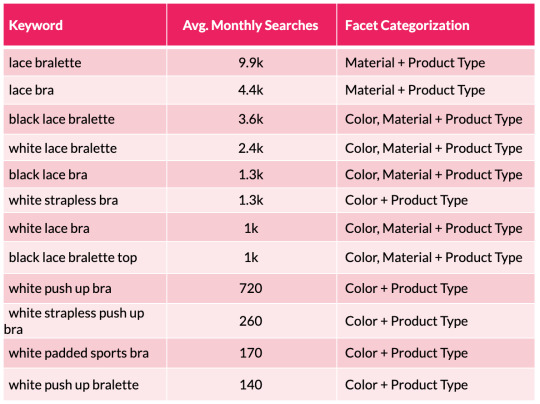
From the table above we can quickly see a pattern emerging with color and material variations appearing across the search terms. We can then substantiate this information with session and revenue estimates with the use of a recognized CTR model. This enables us to help forecast the potential organic uplift and quantify the size of the prize for a number of different scenarios that are on offer from each new facet combination. This may include estimations for securing position 10, 7, 5, 3 and 1 in Google.
One thing to note here is that it’s worth excluding synonyms, as they will falsely inflate your calculations. An example here would be to exclude “storage drawers” (22.2k monthly searchers) when reviewing the performance for “chest of drawers” (201k m/s). Including both variants will cause a false positive result and will lead you to draw incorrect conclusions.
Step 3: Dig deeper into broader terms around offers, ratings, and price
These product filters are found in the “Sort” dropdown box and, from my experience, these are set to “noindex” from the outset as they simply allow users to re-order page results. Certainly, content management systems like Shopify and Shopware have this as a default.
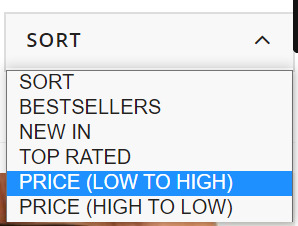
This makes sense since their purpose is to allow visitors to simply sort or narrow page content rather than offering alternative results and additional value (which is offered through faceted navigation). As such, filter typically produce duplicate results which should not be discoverable beyond the immediate moment. But this hard-and-fast rule doesn’t always apply perfectly in the real world. This is why we need to look at our individual industries and understand what’s important to our unique set of customers.
If we look at the world of gifting, we often see people shopping with a particular budget in mind. Therefore, terms like “birthday gift under £20” (40 m/s) or “Secret Santa gift under £10” (2.9k m/s) are reasonably common, and opening up relevant listing pages could be useful for shoppers.
Step 4: The technical steps
Facet taxonomies are hugely complex and the number of attributes that can be strung together increases with the size of the domain. We, therefore, need to carefully manage the flood gates and mitigate against any potential risks including crawl inefficiencies and link equity dilution.
We can do this by:
1. Avoiding thin/doorway pages by regularly re-assessing your product offering. For instance, you may consider there to be little value in creating a new listings page if you’re selling a very small range of low price point products. In this case, you may decide against opening up an additional Product Listing Page when you sell as few as 10 eligible products. However, this is not a fixed rule, so it’s quite possible that your criteria may be lower for particular product lines. Either way, these numbers will change over time. Consider seasonal trends, when new collections are launched, and when they become discontinued. Setting up a product retirement strategy to manage expired products and categories at scale in parallel with this step is also highly recommended.
2. Prevent content cannibalization by arranging selected facets according to their value and significance. “Size” is very important for some electrical goods like TVs, laptops, and cameras, but is less so for beauty accessories or vacuum cleaners. You must also make sure page content is distinctive and reflects the focus of your chosen facet(s). Refer to step 5 for more details.
3. Follow the sequence in which adjectives and facets are typically selected by your customers. This can vary depending on where your audience lives. So, whilst products generally have five or more distinguishable features, English vernacular determines that we use more than four adjectives (e.g. size + color + material + shape) to describe something.
4. Control the controllables by dealing with overlapping variations. This typically occurs when multiples co-exist and each exhibits good search metrics. For instance, it’s reasonable for someone to simultaneously look for several color and/or fabric combinations in the different ways below.
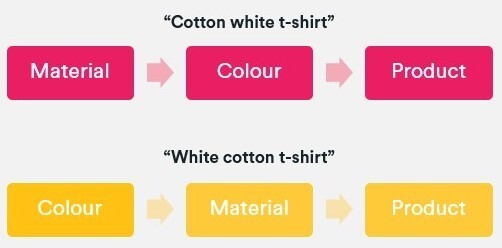
When this situation occurs, we should follow the same linguistic rules as above and choose a preferred sequence. In this case, it would be color + material + product type.
In comparison to the noindex tag suggested for on-page filters you should canonicalize unnecessary facets to their parent page (remembering that this is merely a hint and not a directive). This will enable you to control how crawlers deal with highly comparable result pages and will, therefore, help to prevent your site from being demoted in the SERPs. Dynamic search parameters should continue to be defined with a “noindex, nofollow” meta robots tag, disallowed in the robots.txt file, and configured through Google’s URL parameter tool (within your Search Console account) to tell crawlers the purpose of your parameters and how you would like them to be treated. This is a helpful guide on parameter handling for Googlebots, but bear in mind that this last tip won’t influence how Bing or Yahoo user-agents interpret these pages.
5. Open your facets in phases and cultivate it into a test-and-learn process. This will enable you to identify issues a lot sooner and implement facet-wide solutions in a timely manner. Without having to unravel these additional layers of complexity, problems such as crawl inefficiencies, PageRank dilution, or excessive indexation can be swiftly resolved.
To show you what this could look like, I’ve provided a phasing plan that was created for one of our e-commerce clients. Our research showed a significant SEO opportunity for opening up some of the facets and filters: potential +£263Kpcm for the “colour + type” facet (UK):
What’s more, when we extended our forecast to include other facet combinations, we calculated an additional revenue opportunity of up to +£207K/pcm (before filtering out combinations with no products offering).
Step 5: Optimize your facet URLs
Optimize your new facet category URLs to establish relevancy for your selected search terms. The key on-page elements to focus on include:
URL
Page title
Breadcrumb anchor texts
H tags
Content snippets (e.g. introductory text and FAQ copy)
Image ALT texts
Product names
Link out to similar facet category pages (i.e. via a “You May Also Like” feature box)
David’s Bridal is a good example of a retailer that has done this well. Looking back at the ‘Long Sleeve Wedding Dress’ Product Listing Page, we can see that they’ve curated unique content and followed fundamental optimization tactics on the landing page in a way that feels helpful to the user.
URL: davidsbridal.com/long-sleeve-wedding-dresses
Page Title: Long Sleeve Wedding Dresses & Gowns | David's Bridal
Meta Description: Do you dream of wearing a long sleeve wedding dress on your big day? Shop David's Bridal wide variety of wedding gowns with sleeves in lace & other designs!
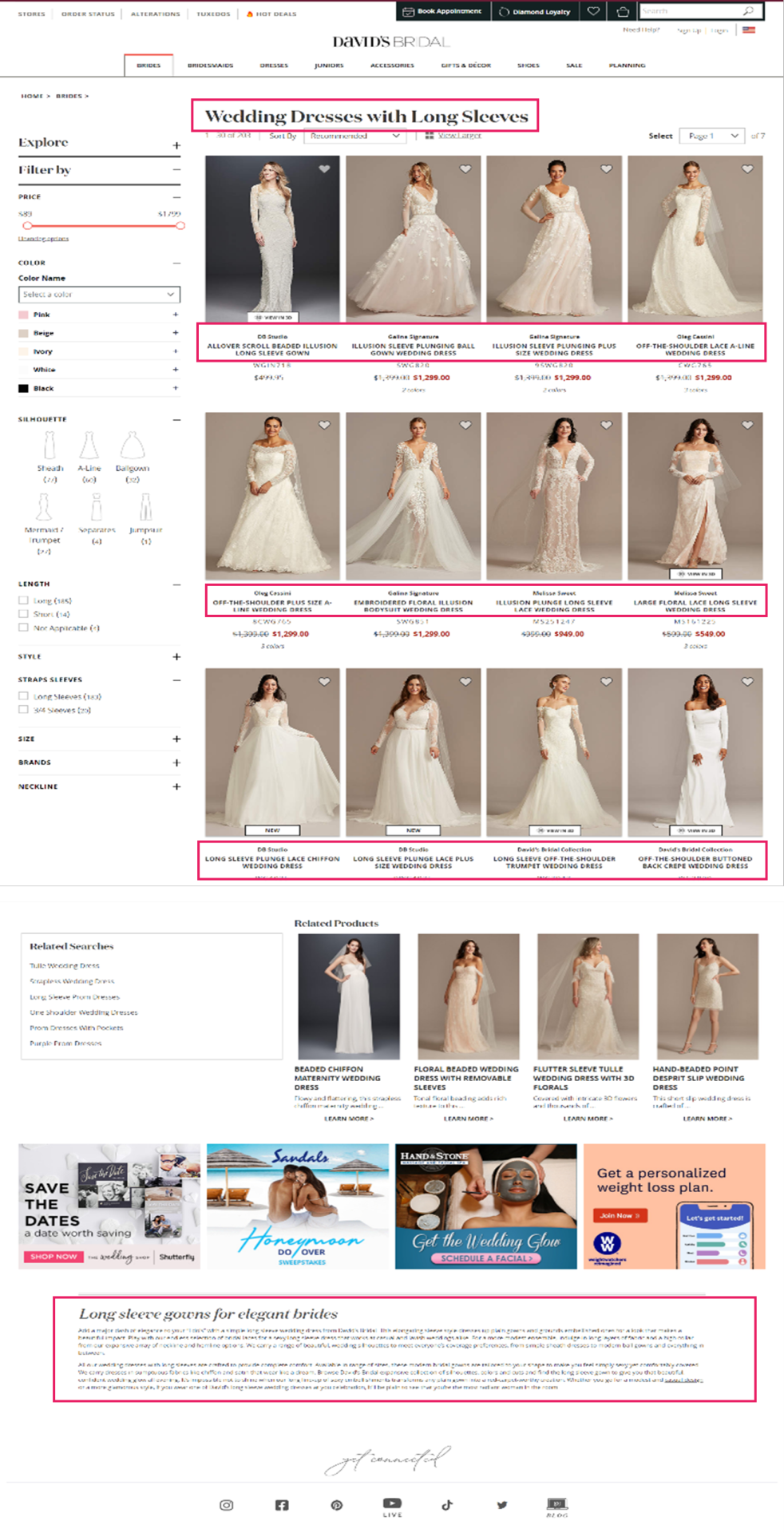
6. Provide accessibility and build page authority
Once you’ve opened up your new facet Product Listing Pages, you need to begin cultivating link equity towards them. This will ensure that they don’t exist as orphan URLs with no PageRank:
Ensure they’re referenced in your product XML sitemap.
If you have one feature per facet URL, then add them to your faceted navigation across CLP and Product Listing Page pages.
If you have two or more features per facet URL, then create a “Popular Searches” or “Related Searches” option within your CLPs.
Utilize your mega menu to showcase your new category landing pages. This will not only allow you to direct a large proportion of link equity, but it will also secure the highest click-through rate amongst your visitors.
Integrate your editorial strategy by creating engaging content with in-copy links. Think about how you can use descriptive long-tail anchor text about the Product Listing Page you want to link to rather than relying on “click here” or “see more”.
Connect to them via href links so you’re not solely relying on links from the main navigation or content hyperlinks. As this is difficult to do at scale, it can be done through modules such as “related categories”, “other subcategories”, “related products”, etc.
Devise strategic outreach campaigns that will secure quality, external backlinks to them.
Implementing this holistic and robust strategy will help you to secure exponential growth from your new commercial landing pages.
Conclusion
There is a great deal of organic opportunity that exists within your faceted navigation if you begin to leverage mid- and long-tail search terms.
Seek out the opportunity from extended keyword research and competitor analysis before deciding which variants fulfill consumer demands and deliver optimal organic sessions and onsite conversions. Configure a single faceted URL for each opportunity and open them up for crawl and indexation. Ensure PageRank is distributed to them (both internally and externally) and develop your landing page content in line with quality optimization practices. This approach will help you to avoid having crawl inefficiencies, over indexation, cannibalization, or having thin doorway pages. In turn, your website will be better suited to attract highly-targeted users and guide them down the purchase funnel.
Maximizing UX and reducing reliance on other marketing channels means that your faceted navigation can truly deliver organic ROI. We have seen this work for our clients.
0 notes
Text
Fulfill Untapped Customer Demands Through Your Faceted Navigation
Faceted navigation allows customers to narrow down search results based on specific product attributes. They typically exist on Product Listing Pages (PLPs) and are a great way to help users intuitively discover products but managing this filtering system is a common SEO challenge. Crawling and indexation need to be controlled.
However, if we look beyond their inherent functionality, facets can offer us considerable potential. By centering your secondary navigation on long-tail keyword opportunities, you’ll be able to strategically utilize consumer intent, secure additional web conversions, and boost revenue levels.
Match consumer intent with long-tail search queries
Having an established brand and a solid domain backlink profile won’t guarantee success. This is great news for smaller brands, as industry giants aren’t necessarily going to win at this game.
If we search for “long sleeve wedding dresses”, we can see how David’s Bridal’s optimized facet page (Domain Authority: 67/100, Page Authority: 47 / 100) has obtained the top ranking position, while Nordstrom’s result (Domain Authority: 87/100, Page Authority: 39/100) appears in the third position for this particular query. We’ll take a look at what makes this page so effective later.
When looking at how we can optimize faceted navigations, it’s important to recognize that product attributes convey consumer needs and aspirations. If, for example, I’m looking for a wedding dress, then I may tailor my search by the color, fabric, neckline shape, and the sleeve length.
According to the search demand curve, long-tail queries account for up to 70% of all organic searches. They are highly targeted queries that offer big traffic-driving opportunities.
In the last few years, we’ve seen a big shift in the industry towards capitalizing this intent with long-form content. Blog articles and style guides have become the go-to methods for many to capture these visitors, as we can see from the examples taken from Marks & Spencers’ "Inspire Me" section:

People often look for inspiration when they’re shopping, and these pages provide an effective way to add more internal links to category and product pages. But relying on this approach is one-dimensional, given that these deeper content pages tend to have lower PageRank. An extensive amount of time and effort will, therefore, be required to achieve the desired result.
In comparison, Product Listing Pages usually target broader search terms, and faceted navigations typically exist as passive functions. This is because they’re often blocked from crawlers, making them devoid of any SEO value. Waterstones (a well-known British bookstore) is one retailer that applies this rule for their on-page filters:
In this particular example, I’ve applied a filter to only show me books for 5 – 8 year olds, but the appended URL (https://bit.ly/2VccAT1) is blocked in the robots.txt file. This is going to prevent such pages from being served in the SERPs despite them having the potential to meet specific customer needs. This shows that there can be a fundamental disconnect in matching customer intent to the pages we’re providing them in the organic results.
From the diagram below, we can see how editorial content typically focuses on the “awareness” and “interest” stages, whilst Product Listing Pages tend to be more in line with the “consideration” and “purchase” phases:
Serving the right content to users throughout their buying journey is pivotal to success. For many retailers, competitors are continuing to prioritize broader, high-volume keywords in saturated markets. They’re targeting the same terms to secure a proportion of the same search traffic. This is a very challenging prospect to face, and without carving out a gap in the marketplace, they won’t necessarily deliver the results they seek to secure. Likewise, relying on informational guides to target long-tail keywords means that you’re missing a large percentage of users who have very specific buying requirements. Yes, they’re ready to make a purchase!
By shifting your focus to address your customer’s real needs and expectations, you’ll be able to deliver a satisfying, frictionless experience at every interaction and all the way through to that final purchase.
The solution
Step 1: Conduct long-tail keyword research
Build a really comprehensive view of your potential customers by harnessing data from a variety of sources, including:
a) Keyword research tools like Moz, Google Keyword Planner, and Answer The Public.
b) The SERPs — get inspiration from the auto-suggest results, People Also Ask, and the related search links at the bottom of the page.
c) Competitor activity — aside from using SEO monitoring software, you can use a data mining extension tool like Scraper, which will extract faceted options directly from competitor Product Listing Pages. These tools are often free to download and allow you to quickly transfer product categories.
d) Your Google Search Console, Analytics, and PPC accounts to determine which keywords and URLs are securing the highest number of visits and web conversions. Internal search data can also give you great consumer insights.
e) Speak to your merchandising team to understand product demands and fulfillment capabilities.
Step 2: Group into meaningful sub-topics
Once you’ve collated all this information into a spreadsheet, you’ll be able to discover long-tail, consideration-orientated keywords. While individually they may not boast huge monthly search estimates, they can collectively highlight where purchase intentions can be better fulfilled.
To help illustrate this point, we can look at a small subset of lingerie keywords and the facets the searches represent:

From the table above we can quickly see a pattern emerging with color and material variations appearing across the search terms. We can then substantiate this information with session and revenue estimates with the use of a recognized CTR model. This enables us to help forecast the potential organic uplift and quantify the size of the prize for a number of different scenarios that are on offer from each new facet combination. This may include estimations for securing position 10, 7, 5, 3 and 1 in Google.
One thing to note here is that it’s worth excluding synonyms, as they will falsely inflate your calculations. An example here would be to exclude “storage drawers” (22.2k monthly searchers) when reviewing the performance for “chest of drawers” (201k m/s). Including both variants will cause a false positive result and will lead you to draw incorrect conclusions.
Step 3: Dig deeper into broader terms around offers, ratings, and price
These product filters are found in the “Sort” dropdown box and, from my experience, these are set to “noindex” from the outset as they simply allow users to re-order page results. Certainly, content management systems like Shopify and Shopware have this as a default.
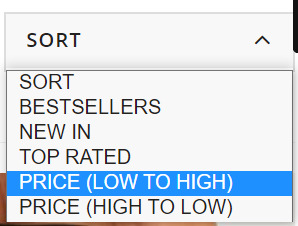
This makes sense since their purpose is to allow visitors to simply sort or narrow page content rather than offering alternative results and additional value (which is offered through faceted navigation). As such, filter typically produce duplicate results which should not be discoverable beyond the immediate moment. But this hard-and-fast rule doesn’t always apply perfectly in the real world. This is why we need to look at our individual industries and understand what’s important to our unique set of customers.
If we look at the world of gifting, we often see people shopping with a particular budget in mind. Therefore, terms like “birthday gift under £20” (40 m/s) or “Secret Santa gift under £10” (2.9k m/s) are reasonably common, and opening up relevant listing pages could be useful for shoppers.
Step 4: The technical steps
Facet taxonomies are hugely complex and the number of attributes that can be strung together increases with the size of the domain. We, therefore, need to carefully manage the flood gates and mitigate against any potential risks including crawl inefficiencies and link equity dilution.
We can do this by:
1. Avoiding thin/doorway pages by regularly re-assessing your product offering. For instance, you may consider there to be little value in creating a new listings page if you’re selling a very small range of low price point products. In this case, you may decide against opening up an additional Product Listing Page when you sell as few as 10 eligible products. However, this is not a fixed rule, so it’s quite possible that your criteria may be lower for particular product lines. Either way, these numbers will change over time. Consider seasonal trends, when new collections are launched, and when they become discontinued. Setting up a product retirement strategy to manage expired products and categories at scale in parallel with this step is also highly recommended.
2. Prevent content cannibalization by arranging selected facets according to their value and significance. “Size” is very important for some electrical goods like TVs, laptops, and cameras, but is less so for beauty accessories or vacuum cleaners. You must also make sure page content is distinctive and reflects the focus of your chosen facet(s). Refer to step 5 for more details.
3. Follow the sequence in which adjectives and facets are typically selected by your customers. This can vary depending on where your audience lives. So, whilst products generally have five or more distinguishable features, English vernacular determines that we use more than four adjectives (e.g. size + color + material + shape) to describe something.
4. Control the controllables by dealing with overlapping variations. This typically occurs when multiples co-exist and each exhibits good search metrics. For instance, it’s reasonable for someone to simultaneously look for several color and/or fabric combinations in the different ways below.

When this situation occurs, we should follow the same linguistic rules as above and choose a preferred sequence. In this case, it would be color + material + product type.
In comparison to the noindex tag suggested for on-page filters you should canonicalize unnecessary facets to their parent page (remembering that this is merely a hint and not a directive). This will enable you to control how crawlers deal with highly comparable result pages and will, therefore, help to prevent your site from being demoted in the SERPs. Dynamic search parameters should continue to be defined with a “noindex, nofollow” meta robots tag, disallowed in the robots.txt file, and configured through Google’s URL parameter tool (within your Search Console account) to tell crawlers the purpose of your parameters and how you would like them to be treated. This is a helpful guide on parameter handling for Googlebots, but bear in mind that this last tip won’t influence how Bing or Yahoo user-agents interpret these pages.
5. Open your facets in phases and cultivate it into a test-and-learn process. This will enable you to identify issues a lot sooner and implement facet-wide solutions in a timely manner. Without having to unravel these additional layers of complexity, problems such as crawl inefficiencies, PageRank dilution, or excessive indexation can be swiftly resolved.
To show you what this could look like, I’ve provided a phasing plan that was created for one of our e-commerce clients. Our research showed a significant SEO opportunity for opening up some of the facets and filters: potential +£263Kpcm for the “colour + type” facet (UK):
What’s more, when we extended our forecast to include other facet combinations, we calculated an additional revenue opportunity of up to +£207K/pcm (before filtering out combinations with no products offering).
Step 5: Optimize your facet URLs
Optimize your new facet category URLs to establish relevancy for your selected search terms. The key on-page elements to focus on include:
URL
Page title
Breadcrumb anchor texts
H tags
Content snippets (e.g. introductory text and FAQ copy)
Image ALT texts
Product names
Link out to similar facet category pages (i.e. via a “You May Also Like” feature box)
David’s Bridal is a good example of a retailer that has done this well. Looking back at the ‘Long Sleeve Wedding Dress’ Product Listing Page, we can see that they’ve curated unique content and followed fundamental optimization tactics on the landing page in a way that feels helpful to the user.
URL: davidsbridal.com/long-sleeve-wedding-dresses
Page Title: Long Sleeve Wedding Dresses & Gowns | David's Bridal
Meta Description: Do you dream of wearing a long sleeve wedding dress on your big day? Shop David's Bridal wide variety of wedding gowns with sleeves in lace & other designs!

6. Provide accessibility and build page authority
Once you’ve opened up your new facet Product Listing Pages, you need to begin cultivating link equity towards them. This will ensure that they don’t exist as orphan URLs with no PageRank:
Ensure they’re referenced in your product XML sitemap.
If you have one feature per facet URL, then add them to your faceted navigation across CLP and Product Listing Page pages.
If you have two or more features per facet URL, then create a “Popular Searches” or “Related Searches” option within your CLPs.
Utilize your mega menu to showcase your new category landing pages. This will not only allow you to direct a large proportion of link equity, but it will also secure the highest click-through rate amongst your visitors.
Integrate your editorial strategy by creating engaging content with in-copy links. Think about how you can use descriptive long-tail anchor text about the Product Listing Page you want to link to rather than relying on “click here” or “see more”.
Connect to them via href links so you’re not solely relying on links from the main navigation or content hyperlinks. As this is difficult to do at scale, it can be done through modules such as “related categories”, “other subcategories”, “related products”, etc.
Devise strategic outreach campaigns that will secure quality, external backlinks to them.
Implementing this holistic and robust strategy will help you to secure exponential growth from your new commercial landing pages.
Conclusion
There is a great deal of organic opportunity that exists within your faceted navigation if you begin to leverage mid- and long-tail search terms.
Seek out the opportunity from extended keyword research and competitor analysis before deciding which variants fulfill consumer demands and deliver optimal organic sessions and onsite conversions. Configure a single faceted URL for each opportunity and open them up for crawl and indexation. Ensure PageRank is distributed to them (both internally and externally) and develop your landing page content in line with quality optimization practices. This approach will help you to avoid having crawl inefficiencies, over indexation, cannibalization, or having thin doorway pages. In turn, your website will be better suited to attract highly-targeted users and guide them down the purchase funnel.
Maximizing UX and reducing reliance on other marketing channels means that your faceted navigation can truly deliver organic ROI. We have seen this work for our clients.
0 notes
Text
Fulfill Untapped Customer Demands Through Your Faceted Navigation
Faceted navigation allows customers to narrow down search results based on specific product attributes. They typically exist on Product Listing Pages (PLPs) and are a great way to help users intuitively discover products but managing this filtering system is a common SEO challenge. Crawling and indexation need to be controlled.
However, if we look beyond their inherent functionality, facets can offer us considerable potential. By centering your secondary navigation on long-tail keyword opportunities, you’ll be able to strategically utilize consumer intent, secure additional web conversions, and boost revenue levels.
Match consumer intent with long-tail search queries
Having an established brand and a solid domain backlink profile won’t guarantee success. This is great news for smaller brands, as industry giants aren’t necessarily going to win at this game.
If we search for “long sleeve wedding dresses”, we can see how David’s Bridal’s optimized facet page (Domain Authority: 67/100, Page Authority: 47 / 100) has obtained the top ranking position, while Nordstrom’s result (Domain Authority: 87/100, Page Authority: 39/100) appears in the third position for this particular query. We’ll take a look at what makes this page so effective later.
When looking at how we can optimize faceted navigations, it’s important to recognize that product attributes convey consumer needs and aspirations. If, for example, I’m looking for a wedding dress, then I may tailor my search by the color, fabric, neckline shape, and the sleeve length.
According to the search demand curve, long-tail queries account for up to 70% of all organic searches. They are highly targeted queries that offer big traffic-driving opportunities.
In the last few years, we’ve seen a big shift in the industry towards capitalizing this intent with long-form content. Blog articles and style guides have become the go-to methods for many to capture these visitors, as we can see from the examples taken from Marks & Spencers’ "Inspire Me" section:

People often look for inspiration when they’re shopping, and these pages provide an effective way to add more internal links to category and product pages. But relying on this approach is one-dimensional, given that these deeper content pages tend to have lower PageRank. An extensive amount of time and effort will, therefore, be required to achieve the desired result.
In comparison, Product Listing Pages usually target broader search terms, and faceted navigations typically exist as passive functions. This is because they’re often blocked from crawlers, making them devoid of any SEO value. Waterstones (a well-known British bookstore) is one retailer that applies this rule for their on-page filters:
In this particular example, I’ve applied a filter to only show me books for 5 – 8 year olds, but the appended URL (https://ift.tt/3xrpOJS) is blocked in the robots.txt file. This is going to prevent such pages from being served in the SERPs despite them having the potential to meet specific customer needs. This shows that there can be a fundamental disconnect in matching customer intent to the pages we’re providing them in the organic results.
From the diagram below, we can see how editorial content typically focuses on the “awareness” and “interest” stages, whilst Product Listing Pages tend to be more in line with the “consideration” and “purchase” phases:
Serving the right content to users throughout their buying journey is pivotal to success. For many retailers, competitors are continuing to prioritize broader, high-volume keywords in saturated markets. They’re targeting the same terms to secure a proportion of the same search traffic. This is a very challenging prospect to face, and without carving out a gap in the marketplace, they won’t necessarily deliver the results they seek to secure. Likewise, relying on informational guides to target long-tail keywords means that you’re missing a large percentage of users who have very specific buying requirements. Yes, they’re ready to make a purchase!
By shifting your focus to address your customer’s real needs and expectations, you’ll be able to deliver a satisfying, frictionless experience at every interaction and all the way through to that final purchase.
The solution
Step 1: Conduct long-tail keyword research
Build a really comprehensive view of your potential customers by harnessing data from a variety of sources, including:
a) Keyword research tools like Moz, Google Keyword Planner, and Answer The Public.
b) The SERPs — get inspiration from the auto-suggest results, People Also Ask, and the related search links at the bottom of the page.
c) Competitor activity — aside from using SEO monitoring software, you can use a data mining extension tool like Scraper, which will extract faceted options directly from competitor Product Listing Pages. These tools are often free to download and allow you to quickly transfer product categories.
d) Your Google Search Console, Analytics, and PPC accounts to determine which keywords and URLs are securing the highest number of visits and web conversions. Internal search data can also give you great consumer insights.
e) Speak to your merchandising team to understand product demands and fulfillment capabilities.
Step 2: Group into meaningful sub-topics
Once you’ve collated all this information into a spreadsheet, you’ll be able to discover long-tail, consideration-orientated keywords. While individually they may not boast huge monthly search estimates, they can collectively highlight where purchase intentions can be better fulfilled.
To help illustrate this point, we can look at a small subset of lingerie keywords and the facets the searches represent:
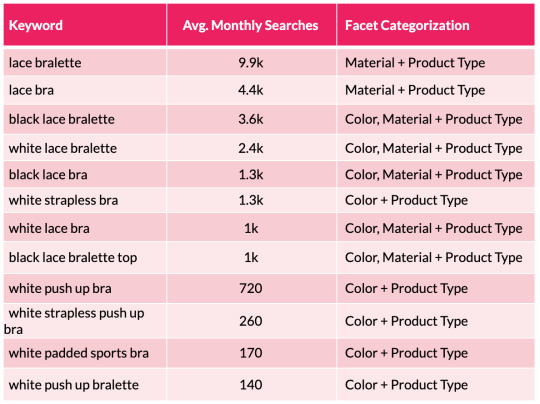
From the table above we can quickly see a pattern emerging with color and material variations appearing across the search terms. We can then substantiate this information with session and revenue estimates with the use of a recognized CTR model. This enables us to help forecast the potential organic uplift and quantify the size of the prize for a number of different scenarios that are on offer from each new facet combination. This may include estimations for securing position 10, 7, 5, 3 and 1 in Google.
One thing to note here is that it’s worth excluding synonyms, as they will falsely inflate your calculations. An example here would be to exclude “storage drawers” (22.2k monthly searchers) when reviewing the performance for “chest of drawers” (201k m/s). Including both variants will cause a false positive result and will lead you to draw incorrect conclusions.
Step 3: Dig deeper into broader terms around offers, ratings, and price
These product filters are found in the “Sort” dropdown box and, from my experience, these are set to “noindex” from the outset as they simply allow users to re-order page results. Certainly, content management systems like Shopify and Shopware have this as a default.

This makes sense since their purpose is to allow visitors to simply sort or narrow page content rather than offering alternative results and additional value (which is offered through faceted navigation). As such, filter typically produce duplicate results which should not be discoverable beyond the immediate moment. But this hard-and-fast rule doesn’t always apply perfectly in the real world. This is why we need to look at our individual industries and understand what’s important to our unique set of customers.
If we look at the world of gifting, we often see people shopping with a particular budget in mind. Therefore, terms like “birthday gift under £20” (40 m/s) or “Secret Santa gift under £10” (2.9k m/s) are reasonably common, and opening up relevant listing pages could be useful for shoppers.
Step 4: The technical steps
Facet taxonomies are hugely complex and the number of attributes that can be strung together increases with the size of the domain. We, therefore, need to carefully manage the flood gates and mitigate against any potential risks including crawl inefficiencies and link equity dilution.
We can do this by:
1. Avoiding thin/doorway pages by regularly re-assessing your product offering. For instance, you may consider there to be little value in creating a new listings page if you’re selling a very small range of low price point products. In this case, you may decide against opening up an additional Product Listing Page when you sell as few as 10 eligible products. However, this is not a fixed rule, so it’s quite possible that your criteria may be lower for particular product lines. Either way, these numbers will change over time. Consider seasonal trends, when new collections are launched, and when they become discontinued. Setting up a product retirement strategy to manage expired products and categories at scale in parallel with this step is also highly recommended.
2. Prevent content cannibalization by arranging selected facets according to their value and significance. “Size” is very important for some electrical goods like TVs, laptops, and cameras, but is less so for beauty accessories or vacuum cleaners. You must also make sure page content is distinctive and reflects the focus of your chosen facet(s). Refer to step 5 for more details.
3. Follow the sequence in which adjectives and facets are typically selected by your customers. This can vary depending on where your audience lives. So, whilst products generally have five or more distinguishable features, English vernacular determines that we use more than four adjectives (e.g. size + color + material + shape) to describe something.
4. Control the controllables by dealing with overlapping variations. This typically occurs when multiples co-exist and each exhibits good search metrics. For instance, it’s reasonable for someone to simultaneously look for several color and/or fabric combinations in the different ways below.
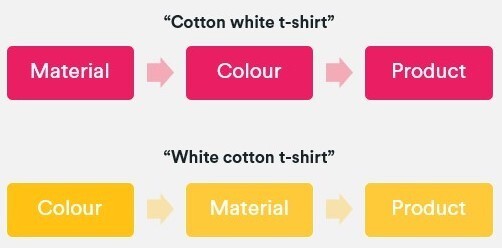
When this situation occurs, we should follow the same linguistic rules as above and choose a preferred sequence. In this case, it would be color + material + product type.
In comparison to the noindex tag suggested for on-page filters you should canonicalize unnecessary facets to their parent page (remembering that this is merely a hint and not a directive). This will enable you to control how crawlers deal with highly comparable result pages and will, therefore, help to prevent your site from being demoted in the SERPs. Dynamic search parameters should continue to be defined with a “noindex, nofollow” meta robots tag, disallowed in the robots.txt file, and configured through Google’s URL parameter tool (within your Search Console account) to tell crawlers the purpose of your parameters and how you would like them to be treated. This is a helpful guide on parameter handling for Googlebots, but bear in mind that this last tip won’t influence how Bing or Yahoo user-agents interpret these pages.
5. Open your facets in phases and cultivate it into a test-and-learn process. This will enable you to identify issues a lot sooner and implement facet-wide solutions in a timely manner. Without having to unravel these additional layers of complexity, problems such as crawl inefficiencies, PageRank dilution, or excessive indexation can be swiftly resolved.
To show you what this could look like, I’ve provided a phasing plan that was created for one of our e-commerce clients. Our research showed a significant SEO opportunity for opening up some of the facets and filters: potential +£263Kpcm for the “colour + type” facet (UK):
What’s more, when we extended our forecast to include other facet combinations, we calculated an additional revenue opportunity of up to +£207K/pcm (before filtering out combinations with no products offering).
Step 5: Optimize your facet URLs
Optimize your new facet category URLs to establish relevancy for your selected search terms. The key on-page elements to focus on include:
URL
Page title
Breadcrumb anchor texts
H tags
Content snippets (e.g. introductory text and FAQ copy)
Image ALT texts
Product names
Link out to similar facet category pages (i.e. via a “You May Also Like” feature box)
David’s Bridal is a good example of a retailer that has done this well. Looking back at the ‘Long Sleeve Wedding Dress’ Product Listing Page, we can see that they’ve curated unique content and followed fundamental optimization tactics on the landing page in a way that feels helpful to the user.
URL: davidsbridal.com/long-sleeve-wedding-dresses
Page Title: Long Sleeve Wedding Dresses & Gowns | David's Bridal
Meta Description: Do you dream of wearing a long sleeve wedding dress on your big day? Shop David's Bridal wide variety of wedding gowns with sleeves in lace & other designs!

6. Provide accessibility and build page authority
Once you’ve opened up your new facet Product Listing Pages, you need to begin cultivating link equity towards them. This will ensure that they don’t exist as orphan URLs with no PageRank:
Ensure they’re referenced in your product XML sitemap.
If you have one feature per facet URL, then add them to your faceted navigation across CLP and Product Listing Page pages.
If you have two or more features per facet URL, then create a “Popular Searches” or “Related Searches” option within your CLPs.
Utilize your mega menu to showcase your new category landing pages. This will not only allow you to direct a large proportion of link equity, but it will also secure the highest click-through rate amongst your visitors.
Integrate your editorial strategy by creating engaging content with in-copy links. Think about how you can use descriptive long-tail anchor text about the Product Listing Page you want to link to rather than relying on “click here” or “see more”.
Connect to them via href links so you’re not solely relying on links from the main navigation or content hyperlinks. As this is difficult to do at scale, it can be done through modules such as “related categories”, “other subcategories”, “related products”, etc.
Devise strategic outreach campaigns that will secure quality, external backlinks to them.
Implementing this holistic and robust strategy will help you to secure exponential growth from your new commercial landing pages.
Conclusion
There is a great deal of organic opportunity that exists within your faceted navigation if you begin to leverage mid- and long-tail search terms.
Seek out the opportunity from extended keyword research and competitor analysis before deciding which variants fulfill consumer demands and deliver optimal organic sessions and onsite conversions. Configure a single faceted URL for each opportunity and open them up for crawl and indexation. Ensure PageRank is distributed to them (both internally and externally) and develop your landing page content in line with quality optimization practices. This approach will help you to avoid having crawl inefficiencies, over indexation, cannibalization, or having thin doorway pages. In turn, your website will be better suited to attract highly-targeted users and guide them down the purchase funnel.
Maximizing UX and reducing reliance on other marketing channels means that your faceted navigation can truly deliver organic ROI. We have seen this work for our clients.
0 notes
Text
Fulfill Untapped Customer Demands Through Your Faceted Navigation
Faceted navigation allows customers to narrow down search results based on specific product attributes. They typically exist on Product Listing Pages (PLPs) and are a great way to help users intuitively discover products but managing this filtering system is a common SEO challenge. Crawling and indexation need to be controlled.
However, if we look beyond their inherent functionality, facets can offer us considerable potential. By centering your secondary navigation on long-tail keyword opportunities, you’ll be able to strategically utilize consumer intent, secure additional web conversions, and boost revenue levels.
Match consumer intent with long-tail search queries
Having an established brand and a solid domain backlink profile won’t guarantee success. This is great news for smaller brands, as industry giants aren’t necessarily going to win at this game.
If we search for “long sleeve wedding dresses”, we can see how David’s Bridal’s optimized facet page (Domain Authority: 67/100, Page Authority: 47 / 100) has obtained the top ranking position, while Nordstrom’s result (Domain Authority: 87/100, Page Authority: 39/100) appears in the third position for this particular query. We’ll take a look at what makes this page so effective later.
When looking at how we can optimize faceted navigations, it’s important to recognize that product attributes convey consumer needs and aspirations. If, for example, I’m looking for a wedding dress, then I may tailor my search by the color, fabric, neckline shape, and the sleeve length.
According to the search demand curve, long-tail queries account for up to 70% of all organic searches. They are highly targeted queries that offer big traffic-driving opportunities.
In the last few years, we’ve seen a big shift in the industry towards capitalizing this intent with long-form content. Blog articles and style guides have become the go-to methods for many to capture these visitors, as we can see from the examples taken from Marks & Spencers’ "Inspire Me" section:
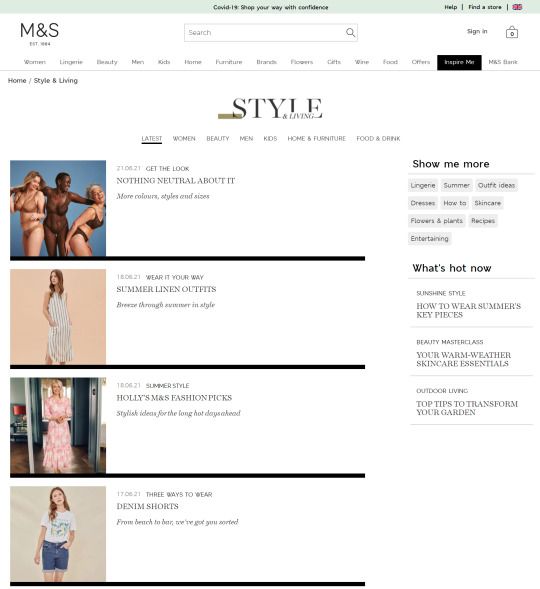
People often look for inspiration when they’re shopping, and these pages provide an effective way to add more internal links to category and product pages. But relying on this approach is one-dimensional, given that these deeper content pages tend to have lower PageRank. An extensive amount of time and effort will, therefore, be required to achieve the desired result.
In comparison, Product Listing Pages usually target broader search terms, and faceted navigations typically exist as passive functions. This is because they’re often blocked from crawlers, making them devoid of any SEO value. Waterstones (a well-known British bookstore) is one retailer that applies this rule for their on-page filters:
In this particular example, I’ve applied a filter to only show me books for 5 – 8 year olds, but the appended URL (https://ift.tt/3xrpOJS) is blocked in the robots.txt file. This is going to prevent such pages from being served in the SERPs despite them having the potential to meet specific customer needs. This shows that there can be a fundamental disconnect in matching customer intent to the pages we’re providing them in the organic results.
From the diagram below, we can see how editorial content typically focuses on the “awareness” and “interest” stages, whilst Product Listing Pages tend to be more in line with the “consideration” and “purchase” phases:
Serving the right content to users throughout their buying journey is pivotal to success. For many retailers, competitors are continuing to prioritize broader, high-volume keywords in saturated markets. They’re targeting the same terms to secure a proportion of the same search traffic. This is a very challenging prospect to face, and without carving out a gap in the marketplace, they won’t necessarily deliver the results they seek to secure. Likewise, relying on informational guides to target long-tail keywords means that you’re missing a large percentage of users who have very specific buying requirements. Yes, they’re ready to make a purchase!
By shifting your focus to address your customer’s real needs and expectations, you’ll be able to deliver a satisfying, frictionless experience at every interaction and all the way through to that final purchase.
The solution
Step 1: Conduct long-tail keyword research
Build a really comprehensive view of your potential customers by harnessing data from a variety of sources, including:
a) Keyword research tools like Moz, Google Keyword Planner, and Answer The Public.
b) The SERPs — get inspiration from the auto-suggest results, People Also Ask, and the related search links at the bottom of the page.
c) Competitor activity — aside from using SEO monitoring software, you can use a data mining extension tool like Scraper, which will extract faceted options directly from competitor Product Listing Pages. These tools are often free to download and allow you to quickly transfer product categories.
d) Your Google Search Console, Analytics, and PPC accounts to determine which keywords and URLs are securing the highest number of visits and web conversions. Internal search data can also give you great consumer insights.
e) Speak to your merchandising team to understand product demands and fulfillment capabilities.
Step 2: Group into meaningful sub-topics
Once you’ve collated all this information into a spreadsheet, you’ll be able to discover long-tail, consideration-orientated keywords. While individually they may not boast huge monthly search estimates, they can collectively highlight where purchase intentions can be better fulfilled.
To help illustrate this point, we can look at a small subset of lingerie keywords and the facets the searches represent:
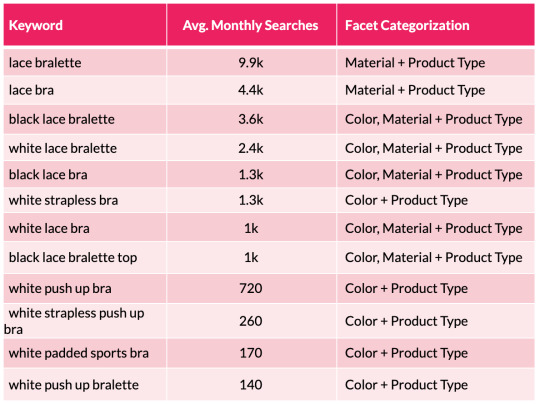
From the table above we can quickly see a pattern emerging with color and material variations appearing across the search terms. We can then substantiate this information with session and revenue estimates with the use of a recognized CTR model. This enables us to help forecast the potential organic uplift and quantify the size of the prize for a number of different scenarios that are on offer from each new facet combination. This may include estimations for securing position 10, 7, 5, 3 and 1 in Google.
One thing to note here is that it’s worth excluding synonyms, as they will falsely inflate your calculations. An example here would be to exclude “storage drawers” (22.2k monthly searchers) when reviewing the performance for “chest of drawers” (201k m/s). Including both variants will cause a false positive result and will lead you to draw incorrect conclusions.
Step 3: Dig deeper into broader terms around offers, ratings, and price
These product filters are found in the “Sort” dropdown box and, from my experience, these are set to “noindex” from the outset as they simply allow users to re-order page results. Certainly, content management systems like Shopify and Shopware have this as a default.
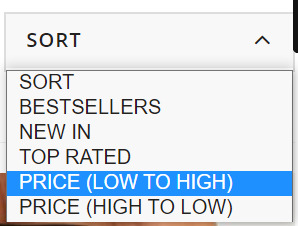
This makes sense since their purpose is to allow visitors to simply sort or narrow page content rather than offering alternative results and additional value (which is offered through faceted navigation). As such, filter typically produce duplicate results which should not be discoverable beyond the immediate moment. But this hard-and-fast rule doesn’t always apply perfectly in the real world. This is why we need to look at our individual industries and understand what’s important to our unique set of customers.
If we look at the world of gifting, we often see people shopping with a particular budget in mind. Therefore, terms like “birthday gift under £20” (40 m/s) or “Secret Santa gift under £10” (2.9k m/s) are reasonably common, and opening up relevant listing pages could be useful for shoppers.
Step 4: The technical steps
Facet taxonomies are hugely complex and the number of attributes that can be strung together increases with the size of the domain. We, therefore, need to carefully manage the flood gates and mitigate against any potential risks including crawl inefficiencies and link equity dilution.
We can do this by:
1. Avoiding thin/doorway pages by regularly re-assessing your product offering. For instance, you may consider there to be little value in creating a new listings page if you’re selling a very small range of low price point products. In this case, you may decide against opening up an additional Product Listing Page when you sell as few as 10 eligible products. However, this is not a fixed rule, so it’s quite possible that your criteria may be lower for particular product lines. Either way, these numbers will change over time. Consider seasonal trends, when new collections are launched, and when they become discontinued. Setting up a product retirement strategy to manage expired products and categories at scale in parallel with this step is also highly recommended.
2. Prevent content cannibalization by arranging selected facets according to their value and significance. “Size” is very important for some electrical goods like TVs, laptops, and cameras, but is less so for beauty accessories or vacuum cleaners. You must also make sure page content is distinctive and reflects the focus of your chosen facet(s). Refer to step 5 for more details.
3. Follow the sequence in which adjectives and facets are typically selected by your customers. This can vary depending on where your audience lives. So, whilst products generally have five or more distinguishable features, English vernacular determines that we use more than four adjectives (e.g. size + color + material + shape) to describe something.
4. Control the controllables by dealing with overlapping variations. This typically occurs when multiples co-exist and each exhibits good search metrics. For instance, it’s reasonable for someone to simultaneously look for several color and/or fabric combinations in the different ways below.
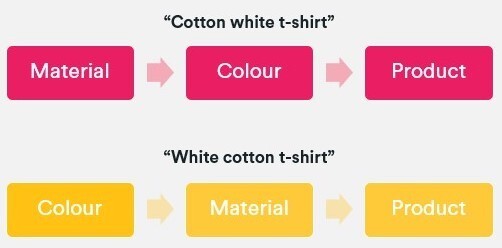
When this situation occurs, we should follow the same linguistic rules as above and choose a preferred sequence. In this case, it would be color + material + product type.
In comparison to the noindex tag suggested for on-page filters you should canonicalize unnecessary facets to their parent page (remembering that this is merely a hint and not a directive). This will enable you to control how crawlers deal with highly comparable result pages and will, therefore, help to prevent your site from being demoted in the SERPs. Dynamic search parameters should continue to be defined with a “noindex, nofollow” meta robots tag, disallowed in the robots.txt file, and configured through Google’s URL parameter tool (within your Search Console account) to tell crawlers the purpose of your parameters and how you would like them to be treated. This is a helpful guide on parameter handling for Googlebots, but bear in mind that this last tip won’t influence how Bing or Yahoo user-agents interpret these pages.
5. Open your facets in phases and cultivate it into a test-and-learn process. This will enable you to identify issues a lot sooner and implement facet-wide solutions in a timely manner. Without having to unravel these additional layers of complexity, problems such as crawl inefficiencies, PageRank dilution, or excessive indexation can be swiftly resolved.
To show you what this could look like, I’ve provided a phasing plan that was created for one of our e-commerce clients. Our research showed a significant SEO opportunity for opening up some of the facets and filters: potential +£263Kpcm for the “colour + type” facet (UK):
What’s more, when we extended our forecast to include other facet combinations, we calculated an additional revenue opportunity of up to +£207K/pcm (before filtering out combinations with no products offering).
Step 5: Optimize your facet URLs
Optimize your new facet category URLs to establish relevancy for your selected search terms. The key on-page elements to focus on include:
URL
Page title
Breadcrumb anchor texts
H tags
Content snippets (e.g. introductory text and FAQ copy)
Image ALT texts
Product names
Link out to similar facet category pages (i.e. via a “You May Also Like” feature box)
David’s Bridal is a good example of a retailer that has done this well. Looking back at the ‘Long Sleeve Wedding Dress’ Product Listing Page, we can see that they’ve curated unique content and followed fundamental optimization tactics on the landing page in a way that feels helpful to the user.
URL: davidsbridal.com/long-sleeve-wedding-dresses
Page Title: Long Sleeve Wedding Dresses & Gowns | David's Bridal
Meta Description: Do you dream of wearing a long sleeve wedding dress on your big day? Shop David's Bridal wide variety of wedding gowns with sleeves in lace & other designs!
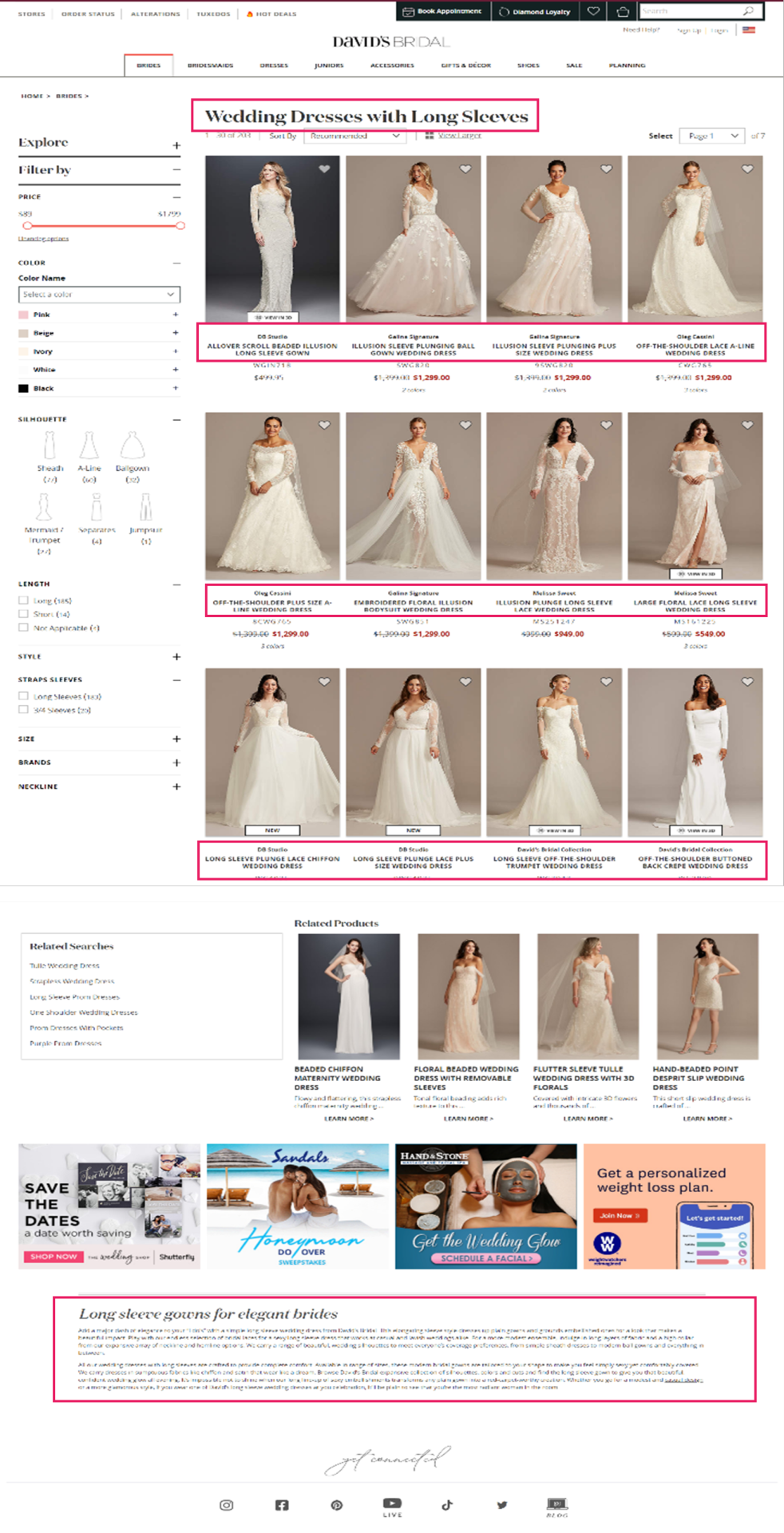
6. Provide accessibility and build page authority
Once you’ve opened up your new facet Product Listing Pages, you need to begin cultivating link equity towards them. This will ensure that they don’t exist as orphan URLs with no PageRank:
Ensure they’re referenced in your product XML sitemap.
If you have one feature per facet URL, then add them to your faceted navigation across CLP and Product Listing Page pages.
If you have two or more features per facet URL, then create a “Popular Searches” or “Related Searches” option within your CLPs.
Utilize your mega menu to showcase your new category landing pages. This will not only allow you to direct a large proportion of link equity, but it will also secure the highest click-through rate amongst your visitors.
Integrate your editorial strategy by creating engaging content with in-copy links. Think about how you can use descriptive long-tail anchor text about the Product Listing Page you want to link to rather than relying on “click here” or “see more”.
Connect to them via href links so you’re not solely relying on links from the main navigation or content hyperlinks. As this is difficult to do at scale, it can be done through modules such as “related categories”, “other subcategories”, “related products”, etc.
Devise strategic outreach campaigns that will secure quality, external backlinks to them.
Implementing this holistic and robust strategy will help you to secure exponential growth from your new commercial landing pages.
Conclusion
There is a great deal of organic opportunity that exists within your faceted navigation if you begin to leverage mid- and long-tail search terms.
Seek out the opportunity from extended keyword research and competitor analysis before deciding which variants fulfill consumer demands and deliver optimal organic sessions and onsite conversions. Configure a single faceted URL for each opportunity and open them up for crawl and indexation. Ensure PageRank is distributed to them (both internally and externally) and develop your landing page content in line with quality optimization practices. This approach will help you to avoid having crawl inefficiencies, over indexation, cannibalization, or having thin doorway pages. In turn, your website will be better suited to attract highly-targeted users and guide them down the purchase funnel.
Maximizing UX and reducing reliance on other marketing channels means that your faceted navigation can truly deliver organic ROI. We have seen this work for our clients.
0 notes
Text
Fulfill Untapped Customer Demands Through Your Faceted Navigation
Faceted navigation allows customers to narrow down search results based on specific product attributes. They typically exist on Product Listing Pages (PLPs) and are a great way to help users intuitively discover products but managing this filtering system is a common SEO challenge. Crawling and indexation need to be controlled.
However, if we look beyond their inherent functionality, facets can offer us considerable potential. By centering your secondary navigation on long-tail keyword opportunities, you’ll be able to strategically utilize consumer intent, secure additional web conversions, and boost revenue levels.
Match consumer intent with long-tail search queries
Having an established brand and a solid domain backlink profile won’t guarantee success. This is great news for smaller brands, as industry giants aren’t necessarily going to win at this game.
If we search for “long sleeve wedding dresses”, we can see how David’s Bridal’s optimized facet page (Domain Authority: 67/100, Page Authority: 47 / 100) has obtained the top ranking position, while Nordstrom’s result (Domain Authority: 87/100, Page Authority: 39/100) appears in the third position for this particular query. We’ll take a look at what makes this page so effective later.
When looking at how we can optimize faceted navigations, it’s important to recognize that product attributes convey consumer needs and aspirations. If, for example, I’m looking for a wedding dress, then I may tailor my search by the color, fabric, neckline shape, and the sleeve length.
According to the search demand curve, long-tail queries account for up to 70% of all organic searches. They are highly targeted queries that offer big traffic-driving opportunities.
In the last few years, we’ve seen a big shift in the industry towards capitalizing this intent with long-form content. Blog articles and style guides have become the go-to methods for many to capture these visitors, as we can see from the examples taken from Marks & Spencers’ "Inspire Me" section:
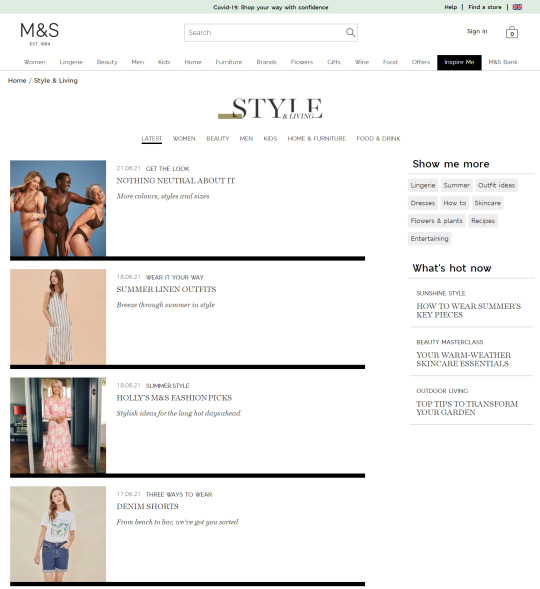
People often look for inspiration when they’re shopping, and these pages provide an effective way to add more internal links to category and product pages. But relying on this approach is one-dimensional, given that these deeper content pages tend to have lower PageRank. An extensive amount of time and effort will, therefore, be required to achieve the desired result.
In comparison, Product Listing Pages usually target broader search terms, and faceted navigations typically exist as passive functions. This is because they’re often blocked from crawlers, making them devoid of any SEO value. Waterstones (a well-known British bookstore) is one retailer that applies this rule for their on-page filters:
In this particular example, I’ve applied a filter to only show me books for 5 – 8 year olds, but the appended URL (https://ift.tt/3xrpOJS) is blocked in the robots.txt file. This is going to prevent such pages from being served in the SERPs despite them having the potential to meet specific customer needs. This shows that there can be a fundamental disconnect in matching customer intent to the pages we’re providing them in the organic results.
From the diagram below, we can see how editorial content typically focuses on the “awareness” and “interest” stages, whilst Product Listing Pages tend to be more in line with the “consideration” and “purchase” phases:
Serving the right content to users throughout their buying journey is pivotal to success. For many retailers, competitors are continuing to prioritize broader, high-volume keywords in saturated markets. They’re targeting the same terms to secure a proportion of the same search traffic. This is a very challenging prospect to face, and without carving out a gap in the marketplace, they won’t necessarily deliver the results they seek to secure. Likewise, relying on informational guides to target long-tail keywords means that you’re missing a large percentage of users who have very specific buying requirements. Yes, they’re ready to make a purchase!
By shifting your focus to address your customer’s real needs and expectations, you’ll be able to deliver a satisfying, frictionless experience at every interaction and all the way through to that final purchase.
The solution
Step 1: Conduct long-tail keyword research
Build a really comprehensive view of your potential customers by harnessing data from a variety of sources, including:
a) Keyword research tools like Moz, Google Keyword Planner, and Answer The Public.
b) The SERPs — get inspiration from the auto-suggest results, People Also Ask, and the related search links at the bottom of the page.
c) Competitor activity — aside from using SEO monitoring software, you can use a data mining extension tool like Scraper, which will extract faceted options directly from competitor Product Listing Pages. These tools are often free to download and allow you to quickly transfer product categories.
d) Your Google Search Console, Analytics, and PPC accounts to determine which keywords and URLs are securing the highest number of visits and web conversions. Internal search data can also give you great consumer insights.
e) Speak to your merchandising team to understand product demands and fulfillment capabilities.
Step 2: Group into meaningful sub-topics
Once you’ve collated all this information into a spreadsheet, you’ll be able to discover long-tail, consideration-orientated keywords. While individually they may not boast huge monthly search estimates, they can collectively highlight where purchase intentions can be better fulfilled.
To help illustrate this point, we can look at a small subset of lingerie keywords and the facets the searches represent:
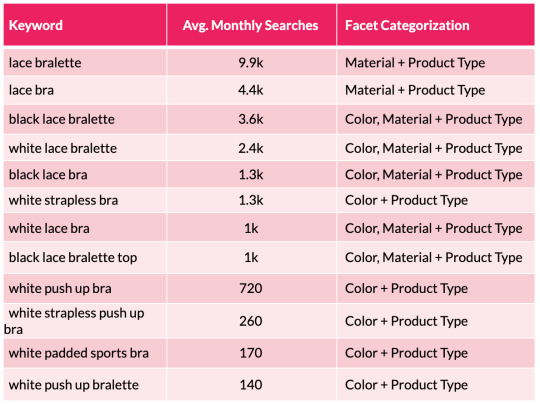
From the table above we can quickly see a pattern emerging with color and material variations appearing across the search terms. We can then substantiate this information with session and revenue estimates with the use of a recognized CTR model. This enables us to help forecast the potential organic uplift and quantify the size of the prize for a number of different scenarios that are on offer from each new facet combination. This may include estimations for securing position 10, 7, 5, 3 and 1 in Google.
One thing to note here is that it’s worth excluding synonyms, as they will falsely inflate your calculations. An example here would be to exclude “storage drawers” (22.2k monthly searchers) when reviewing the performance for “chest of drawers” (201k m/s). Including both variants will cause a false positive result and will lead you to draw incorrect conclusions.
Step 3: Dig deeper into broader terms around offers, ratings, and price
These product filters are found in the “Sort” dropdown box and, from my experience, these are set to “noindex” from the outset as they simply allow users to re-order page results. Certainly, content management systems like Shopify and Shopware have this as a default.

This makes sense since their purpose is to allow visitors to simply sort or narrow page content rather than offering alternative results and additional value (which is offered through faceted navigation). As such, filter typically produce duplicate results which should not be discoverable beyond the immediate moment. But this hard-and-fast rule doesn’t always apply perfectly in the real world. This is why we need to look at our individual industries and understand what’s important to our unique set of customers.
If we look at the world of gifting, we often see people shopping with a particular budget in mind. Therefore, terms like “birthday gift under £20” (40 m/s) or “Secret Santa gift under £10” (2.9k m/s) are reasonably common, and opening up relevant listing pages could be useful for shoppers.
Step 4: The technical steps
Facet taxonomies are hugely complex and the number of attributes that can be strung together increases with the size of the domain. We, therefore, need to carefully manage the flood gates and mitigate against any potential risks including crawl inefficiencies and link equity dilution.
We can do this by:
1. Avoiding thin/doorway pages by regularly re-assessing your product offering. For instance, you may consider there to be little value in creating a new listings page if you’re selling a very small range of low price point products. In this case, you may decide against opening up an additional Product Listing Page when you sell as few as 10 eligible products. However, this is not a fixed rule, so it’s quite possible that your criteria may be lower for particular product lines. Either way, these numbers will change over time. Consider seasonal trends, when new collections are launched, and when they become discontinued. Setting up a product retirement strategy to manage expired products and categories at scale in parallel with this step is also highly recommended.
2. Prevent content cannibalization by arranging selected facets according to their value and significance. “Size” is very important for some electrical goods like TVs, laptops, and cameras, but is less so for beauty accessories or vacuum cleaners. You must also make sure page content is distinctive and reflects the focus of your chosen facet(s). Refer to step 5 for more details.
3. Follow the sequence in which adjectives and facets are typically selected by your customers. This can vary depending on where your audience lives. So, whilst products generally have five or more distinguishable features, English vernacular determines that we use more than four adjectives (e.g. size + color + material + shape) to describe something.
4. Control the controllables by dealing with overlapping variations. This typically occurs when multiples co-exist and each exhibits good search metrics. For instance, it’s reasonable for someone to simultaneously look for several color and/or fabric combinations in the different ways below.

When this situation occurs, we should follow the same linguistic rules as above and choose a preferred sequence. In this case, it would be color + material + product type.
In comparison to the noindex tag suggested for on-page filters you should canonicalize unnecessary facets to their parent page (remembering that this is merely a hint and not a directive). This will enable you to control how crawlers deal with highly comparable result pages and will, therefore, help to prevent your site from being demoted in the SERPs. Dynamic search parameters should continue to be defined with a “noindex, nofollow” meta robots tag, disallowed in the robots.txt file, and configured through Google’s URL parameter tool (within your Search Console account) to tell crawlers the purpose of your parameters and how you would like them to be treated. This is a helpful guide on parameter handling for Googlebots, but bear in mind that this last tip won’t influence how Bing or Yahoo user-agents interpret these pages.
5. Open your facets in phases and cultivate it into a test-and-learn process. This will enable you to identify issues a lot sooner and implement facet-wide solutions in a timely manner. Without having to unravel these additional layers of complexity, problems such as crawl inefficiencies, PageRank dilution, or excessive indexation can be swiftly resolved.
To show you what this could look like, I’ve provided a phasing plan that was created for one of our e-commerce clients. Our research showed a significant SEO opportunity for opening up some of the facets and filters: potential +£263Kpcm for the “colour + type” facet (UK):
What’s more, when we extended our forecast to include other facet combinations, we calculated an additional revenue opportunity of up to +£207K/pcm (before filtering out combinations with no products offering).
Step 5: Optimize your facet URLs
Optimize your new facet category URLs to establish relevancy for your selected search terms. The key on-page elements to focus on include:
URL
Page title
Breadcrumb anchor texts
H tags
Content snippets (e.g. introductory text and FAQ copy)
Image ALT texts
Product names
Link out to similar facet category pages (i.e. via a “You May Also Like” feature box)
David’s Bridal is a good example of a retailer that has done this well. Looking back at the ‘Long Sleeve Wedding Dress’ Product Listing Page, we can see that they’ve curated unique content and followed fundamental optimization tactics on the landing page in a way that feels helpful to the user.
URL: davidsbridal.com/long-sleeve-wedding-dresses
Page Title: Long Sleeve Wedding Dresses & Gowns | David's Bridal
Meta Description: Do you dream of wearing a long sleeve wedding dress on your big day? Shop David's Bridal wide variety of wedding gowns with sleeves in lace & other designs!

6. Provide accessibility and build page authority
Once you’ve opened up your new facet Product Listing Pages, you need to begin cultivating link equity towards them. This will ensure that they don’t exist as orphan URLs with no PageRank:
Ensure they’re referenced in your product XML sitemap.
If you have one feature per facet URL, then add them to your faceted navigation across CLP and Product Listing Page pages.
If you have two or more features per facet URL, then create a “Popular Searches” or “Related Searches” option within your CLPs.
Utilize your mega menu to showcase your new category landing pages. This will not only allow you to direct a large proportion of link equity, but it will also secure the highest click-through rate amongst your visitors.
Integrate your editorial strategy by creating engaging content with in-copy links. Think about how you can use descriptive long-tail anchor text about the Product Listing Page you want to link to rather than relying on “click here” or “see more”.
Connect to them via href links so you’re not solely relying on links from the main navigation or content hyperlinks. As this is difficult to do at scale, it can be done through modules such as “related categories”, “other subcategories”, “related products”, etc.
Devise strategic outreach campaigns that will secure quality, external backlinks to them.
Implementing this holistic and robust strategy will help you to secure exponential growth from your new commercial landing pages.
Conclusion
There is a great deal of organic opportunity that exists within your faceted navigation if you begin to leverage mid- and long-tail search terms.
Seek out the opportunity from extended keyword research and competitor analysis before deciding which variants fulfill consumer demands and deliver optimal organic sessions and onsite conversions. Configure a single faceted URL for each opportunity and open them up for crawl and indexation. Ensure PageRank is distributed to them (both internally and externally) and develop your landing page content in line with quality optimization practices. This approach will help you to avoid having crawl inefficiencies, over indexation, cannibalization, or having thin doorway pages. In turn, your website will be better suited to attract highly-targeted users and guide them down the purchase funnel.
Maximizing UX and reducing reliance on other marketing channels means that your faceted navigation can truly deliver organic ROI. We have seen this work for our clients.
0 notes
Text
Fulfill Untapped Customer Demands Through Your Faceted Navigation
Faceted navigation allows customers to narrow down search results based on specific product attributes. They typically exist on Product Listing Pages (PLPs) and are a great way to help users intuitively discover products but managing this filtering system is a common SEO challenge. Crawling and indexation need to be controlled.
However, if we look beyond their inherent functionality, facets can offer us considerable potential. By centering your secondary navigation on long-tail keyword opportunities, you’ll be able to strategically utilize consumer intent, secure additional web conversions, and boost revenue levels.
Match consumer intent with long-tail search queries
Having an established brand and a solid domain backlink profile won’t guarantee success. This is great news for smaller brands, as industry giants aren’t necessarily going to win at this game.
If we search for “long sleeve wedding dresses”, we can see how David’s Bridal’s optimized facet page (Domain Authority: 67/100, Page Authority: 47 / 100) has obtained the top ranking position, while Nordstrom’s result (Domain Authority: 87/100, Page Authority: 39/100) appears in the third position for this particular query. We’ll take a look at what makes this page so effective later.
When looking at how we can optimize faceted navigations, it’s important to recognize that product attributes convey consumer needs and aspirations. If, for example, I’m looking for a wedding dress, then I may tailor my search by the color, fabric, neckline shape, and the sleeve length.
According to the search demand curve, long-tail queries account for up to 70% of all organic searches. They are highly targeted queries that offer big traffic-driving opportunities.
In the last few years, we’ve seen a big shift in the industry towards capitalizing this intent with long-form content. Blog articles and style guides have become the go-to methods for many to capture these visitors, as we can see from the examples taken from Marks & Spencers’ "Inspire Me" section:
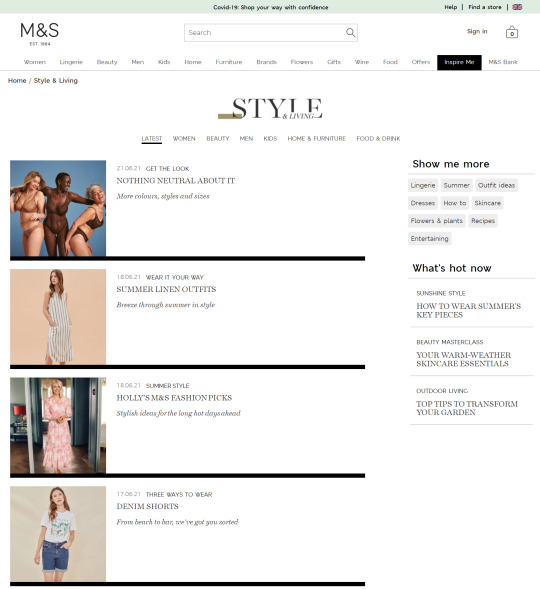
People often look for inspiration when they’re shopping, and these pages provide an effective way to add more internal links to category and product pages. But relying on this approach is one-dimensional, given that these deeper content pages tend to have lower PageRank. An extensive amount of time and effort will, therefore, be required to achieve the desired result.
In comparison, Product Listing Pages usually target broader search terms, and faceted navigations typically exist as passive functions. This is because they’re often blocked from crawlers, making them devoid of any SEO value. Waterstones (a well-known British bookstore) is one retailer that applies this rule for their on-page filters:
In this particular example, I’ve applied a filter to only show me books for 5 – 8 year olds, but the appended URL (https://ift.tt/3xrpOJS) is blocked in the robots.txt file. This is going to prevent such pages from being served in the SERPs despite them having the potential to meet specific customer needs. This shows that there can be a fundamental disconnect in matching customer intent to the pages we’re providing them in the organic results.
From the diagram below, we can see how editorial content typically focuses on the “awareness” and “interest” stages, whilst Product Listing Pages tend to be more in line with the “consideration” and “purchase” phases:
Serving the right content to users throughout their buying journey is pivotal to success. For many retailers, competitors are continuing to prioritize broader, high-volume keywords in saturated markets. They’re targeting the same terms to secure a proportion of the same search traffic. This is a very challenging prospect to face, and without carving out a gap in the marketplace, they won’t necessarily deliver the results they seek to secure. Likewise, relying on informational guides to target long-tail keywords means that you’re missing a large percentage of users who have very specific buying requirements. Yes, they’re ready to make a purchase!
By shifting your focus to address your customer’s real needs and expectations, you’ll be able to deliver a satisfying, frictionless experience at every interaction and all the way through to that final purchase.
The solution
Step 1: Conduct long-tail keyword research
Build a really comprehensive view of your potential customers by harnessing data from a variety of sources, including:
a) Keyword research tools like Moz, Google Keyword Planner, and Answer The Public.
b) The SERPs — get inspiration from the auto-suggest results, People Also Ask, and the related search links at the bottom of the page.
c) Competitor activity — aside from using SEO monitoring software, you can use a data mining extension tool like Scraper, which will extract faceted options directly from competitor Product Listing Pages. These tools are often free to download and allow you to quickly transfer product categories.
d) Your Google Search Console, Analytics, and PPC accounts to determine which keywords and URLs are securing the highest number of visits and web conversions. Internal search data can also give you great consumer insights.
e) Speak to your merchandising team to understand product demands and fulfillment capabilities.
Step 2: Group into meaningful sub-topics
Once you’ve collated all this information into a spreadsheet, you’ll be able to discover long-tail, consideration-orientated keywords. While individually they may not boast huge monthly search estimates, they can collectively highlight where purchase intentions can be better fulfilled.
To help illustrate this point, we can look at a small subset of lingerie keywords and the facets the searches represent:

From the table above we can quickly see a pattern emerging with color and material variations appearing across the search terms. We can then substantiate this information with session and revenue estimates with the use of a recognized CTR model. This enables us to help forecast the potential organic uplift and quantify the size of the prize for a number of different scenarios that are on offer from each new facet combination. This may include estimations for securing position 10, 7, 5, 3 and 1 in Google.
One thing to note here is that it’s worth excluding synonyms, as they will falsely inflate your calculations. An example here would be to exclude “storage drawers” (22.2k monthly searchers) when reviewing the performance for “chest of drawers” (201k m/s). Including both variants will cause a false positive result and will lead you to draw incorrect conclusions.
Step 3: Dig deeper into broader terms around offers, ratings, and price
These product filters are found in the “Sort” dropdown box and, from my experience, these are set to “noindex” from the outset as they simply allow users to re-order page results. Certainly, content management systems like Shopify and Shopware have this as a default.

This makes sense since their purpose is to allow visitors to simply sort or narrow page content rather than offering alternative results and additional value (which is offered through faceted navigation). As such, filter typically produce duplicate results which should not be discoverable beyond the immediate moment. But this hard-and-fast rule doesn’t always apply perfectly in the real world. This is why we need to look at our individual industries and understand what’s important to our unique set of customers.
If we look at the world of gifting, we often see people shopping with a particular budget in mind. Therefore, terms like “birthday gift under £20” (40 m/s) or “Secret Santa gift under £10” (2.9k m/s) are reasonably common, and opening up relevant listing pages could be useful for shoppers.
Step 4: The technical steps
Facet taxonomies are hugely complex and the number of attributes that can be strung together increases with the size of the domain. We, therefore, need to carefully manage the flood gates and mitigate against any potential risks including crawl inefficiencies and link equity dilution.
We can do this by:
1. Avoiding thin/doorway pages by regularly re-assessing your product offering. For instance, you may consider there to be little value in creating a new listings page if you’re selling a very small range of low price point products. In this case, you may decide against opening up an additional Product Listing Page when you sell as few as 10 eligible products. However, this is not a fixed rule, so it’s quite possible that your criteria may be lower for particular product lines. Either way, these numbers will change over time. Consider seasonal trends, when new collections are launched, and when they become discontinued. Setting up a product retirement strategy to manage expired products and categories at scale in parallel with this step is also highly recommended.
2. Prevent content cannibalization by arranging selected facets according to their value and significance. “Size” is very important for some electrical goods like TVs, laptops, and cameras, but is less so for beauty accessories or vacuum cleaners. You must also make sure page content is distinctive and reflects the focus of your chosen facet(s). Refer to step 5 for more details.
3. Follow the sequence in which adjectives and facets are typically selected by your customers. This can vary depending on where your audience lives. So, whilst products generally have five or more distinguishable features, English vernacular determines that we use more than four adjectives (e.g. size + color + material + shape) to describe something.
4. Control the controllables by dealing with overlapping variations. This typically occurs when multiples co-exist and each exhibits good search metrics. For instance, it’s reasonable for someone to simultaneously look for several color and/or fabric combinations in the different ways below.
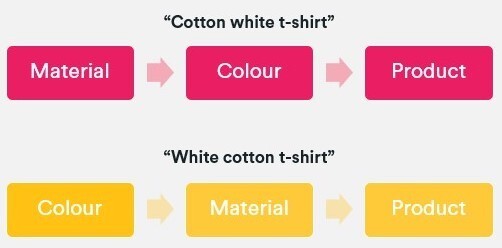
When this situation occurs, we should follow the same linguistic rules as above and choose a preferred sequence. In this case, it would be color + material + product type.
In comparison to the noindex tag suggested for on-page filters you should canonicalize unnecessary facets to their parent page (remembering that this is merely a hint and not a directive). This will enable you to control how crawlers deal with highly comparable result pages and will, therefore, help to prevent your site from being demoted in the SERPs. Dynamic search parameters should continue to be defined with a “noindex, nofollow” meta robots tag, disallowed in the robots.txt file, and configured through Google’s URL parameter tool (within your Search Console account) to tell crawlers the purpose of your parameters and how you would like them to be treated. This is a helpful guide on parameter handling for Googlebots, but bear in mind that this last tip won’t influence how Bing or Yahoo user-agents interpret these pages.
5. Open your facets in phases and cultivate it into a test-and-learn process. This will enable you to identify issues a lot sooner and implement facet-wide solutions in a timely manner. Without having to unravel these additional layers of complexity, problems such as crawl inefficiencies, PageRank dilution, or excessive indexation can be swiftly resolved.
To show you what this could look like, I’ve provided a phasing plan that was created for one of our e-commerce clients. Our research showed a significant SEO opportunity for opening up some of the facets and filters: potential +£263Kpcm for the “colour + type” facet (UK):
What’s more, when we extended our forecast to include other facet combinations, we calculated an additional revenue opportunity of up to +£207K/pcm (before filtering out combinations with no products offering).
Step 5: Optimize your facet URLs
Optimize your new facet category URLs to establish relevancy for your selected search terms. The key on-page elements to focus on include:
URL
Page title
Breadcrumb anchor texts
H tags
Content snippets (e.g. introductory text and FAQ copy)
Image ALT texts
Product names
Link out to similar facet category pages (i.e. via a “You May Also Like” feature box)
David’s Bridal is a good example of a retailer that has done this well. Looking back at the ‘Long Sleeve Wedding Dress’ Product Listing Page, we can see that they’ve curated unique content and followed fundamental optimization tactics on the landing page in a way that feels helpful to the user.
URL: davidsbridal.com/long-sleeve-wedding-dresses
Page Title: Long Sleeve Wedding Dresses & Gowns | David's Bridal
Meta Description: Do you dream of wearing a long sleeve wedding dress on your big day? Shop David's Bridal wide variety of wedding gowns with sleeves in lace & other designs!

6. Provide accessibility and build page authority
Once you’ve opened up your new facet Product Listing Pages, you need to begin cultivating link equity towards them. This will ensure that they don’t exist as orphan URLs with no PageRank:
Ensure they’re referenced in your product XML sitemap.
If you have one feature per facet URL, then add them to your faceted navigation across CLP and Product Listing Page pages.
If you have two or more features per facet URL, then create a “Popular Searches” or “Related Searches” option within your CLPs.
Utilize your mega menu to showcase your new category landing pages. This will not only allow you to direct a large proportion of link equity, but it will also secure the highest click-through rate amongst your visitors.
Integrate your editorial strategy by creating engaging content with in-copy links. Think about how you can use descriptive long-tail anchor text about the Product Listing Page you want to link to rather than relying on “click here” or “see more”.
Connect to them via href links so you’re not solely relying on links from the main navigation or content hyperlinks. As this is difficult to do at scale, it can be done through modules such as “related categories”, “other subcategories”, “related products”, etc.
Devise strategic outreach campaigns that will secure quality, external backlinks to them.
Implementing this holistic and robust strategy will help you to secure exponential growth from your new commercial landing pages.
Conclusion
There is a great deal of organic opportunity that exists within your faceted navigation if you begin to leverage mid- and long-tail search terms.
Seek out the opportunity from extended keyword research and competitor analysis before deciding which variants fulfill consumer demands and deliver optimal organic sessions and onsite conversions. Configure a single faceted URL for each opportunity and open them up for crawl and indexation. Ensure PageRank is distributed to them (both internally and externally) and develop your landing page content in line with quality optimization practices. This approach will help you to avoid having crawl inefficiencies, over indexation, cannibalization, or having thin doorway pages. In turn, your website will be better suited to attract highly-targeted users and guide them down the purchase funnel.
Maximizing UX and reducing reliance on other marketing channels means that your faceted navigation can truly deliver organic ROI. We have seen this work for our clients.
https://ift.tt/3qUUr85
0 notes
Text
Fulfill Untapped Customer Demands Through Your Faceted Navigation
Faceted navigation allows customers to narrow down search results based on specific product attributes. They typically exist on Product Listing Pages (PLPs) and are a great way to help users intuitively discover products but managing this filtering system is a common SEO challenge. Crawling and indexation need to be controlled.
However, if we look beyond their inherent functionality, facets can offer us considerable potential. By centering your secondary navigation on long-tail keyword opportunities, you’ll be able to strategically utilize consumer intent, secure additional web conversions, and boost revenue levels.
Match consumer intent with long-tail search queries
Having an established brand and a solid domain backlink profile won’t guarantee success. This is great news for smaller brands, as industry giants aren’t necessarily going to win at this game.
If we search for “long sleeve wedding dresses”, we can see how David’s Bridal’s optimized facet page (Domain Authority: 67/100, Page Authority: 47 / 100) has obtained the top ranking position, while Nordstrom’s result (Domain Authority: 87/100, Page Authority: 39/100) appears in the third position for this particular query. We’ll take a look at what makes this page so effective later.
When looking at how we can optimize faceted navigations, it’s important to recognize that product attributes convey consumer needs and aspirations. If, for example, I’m looking for a wedding dress, then I may tailor my search by the color, fabric, neckline shape, and the sleeve length.
According to the search demand curve, long-tail queries account for up to 70% of all organic searches. They are highly targeted queries that offer big traffic-driving opportunities.
In the last few years, we’ve seen a big shift in the industry towards capitalizing this intent with long-form content. Blog articles and style guides have become the go-to methods for many to capture these visitors, as we can see from the examples taken from Marks & Spencers’ "Inspire Me" section:
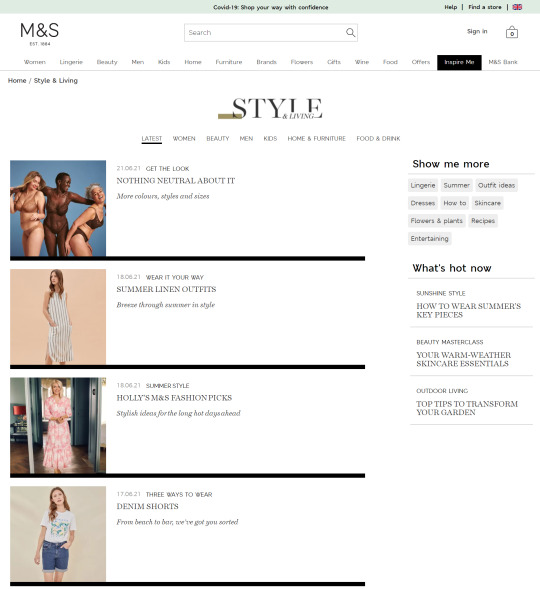
People often look for inspiration when they’re shopping, and these pages provide an effective way to add more internal links to category and product pages. But relying on this approach is one-dimensional, given that these deeper content pages tend to have lower PageRank. An extensive amount of time and effort will, therefore, be required to achieve the desired result.
In comparison, Product Listing Pages usually target broader search terms, and faceted navigations typically exist as passive functions. This is because they’re often blocked from crawlers, making them devoid of any SEO value. Waterstones (a well-known British bookstore) is one retailer that applies this rule for their on-page filters:
In this particular example, I’ve applied a filter to only show me books for 5 – 8 year olds, but the appended URL (https://www.waterstones.com/category/childrens-teenage/facet/498) is blocked in the robots.txt file. This is going to prevent such pages from being served in the SERPs despite them having the potential to meet specific customer needs. This shows that there can be a fundamental disconnect in matching customer intent to the pages we’re providing them in the organic results.
From the diagram below, we can see how editorial content typically focuses on the “awareness” and “interest” stages, whilst Product Listing Pages tend to be more in line with the “consideration” and “purchase” phases:
Serving the right content to users throughout their buying journey is pivotal to success. For many retailers, competitors are continuing to prioritize broader, high-volume keywords in saturated markets. They’re targeting the same terms to secure a proportion of the same search traffic. This is a very challenging prospect to face, and without carving out a gap in the marketplace, they won’t necessarily deliver the results they seek to secure. Likewise, relying on informational guides to target long-tail keywords means that you’re missing a large percentage of users who have very specific buying requirements. Yes, they’re ready to make a purchase!
By shifting your focus to address your customer’s real needs and expectations, you’ll be able to deliver a satisfying, frictionless experience at every interaction and all the way through to that final purchase.
The solution
Step 1: Conduct long-tail keyword research
Build a really comprehensive view of your potential customers by harnessing data from a variety of sources, including:
a) Keyword research tools like Moz, Google Keyword Planner, and Answer The Public.
b) The SERPs — get inspiration from the auto-suggest results, People Also Ask, and the related search links at the bottom of the page.
c) Competitor activity — aside from using SEO monitoring software, you can use a data mining extension tool like Scraper, which will extract faceted options directly from competitor Product Listing Pages. These tools are often free to download and allow you to quickly transfer product categories.
d) Your Google Search Console, Analytics, and PPC accounts to determine which keywords and URLs are securing the highest number of visits and web conversions. Internal search data can also give you great consumer insights.
e) Speak to your merchandising team to understand product demands and fulfillment capabilities.
Step 2: Group into meaningful sub-topics
Once you’ve collated all this information into a spreadsheet, you’ll be able to discover long-tail, consideration-orientated keywords. While individually they may not boast huge monthly search estimates, they can collectively highlight where purchase intentions can be better fulfilled.
To help illustrate this point, we can look at a small subset of lingerie keywords and the facets the searches represent:

From the table above we can quickly see a pattern emerging with color and material variations appearing across the search terms. We can then substantiate this information with session and revenue estimates with the use of a recognized CTR model. This enables us to help forecast the potential organic uplift and quantify the size of the prize for a number of different scenarios that are on offer from each new facet combination. This may include estimations for securing position 10, 7, 5, 3 and 1 in Google.
One thing to note here is that it’s worth excluding synonyms, as they will falsely inflate your calculations. An example here would be to exclude “storage drawers” (22.2k monthly searchers) when reviewing the performance for “chest of drawers” (201k m/s). Including both variants will cause a false positive result and will lead you to draw incorrect conclusions.
Step 3: Dig deeper into broader terms around offers, ratings, and price
These product filters are found in the “Sort” dropdown box and, from my experience, these are set to “noindex” from the outset as they simply allow users to re-order page results. Certainly, content management systems like Shopify and Shopware have this as a default.
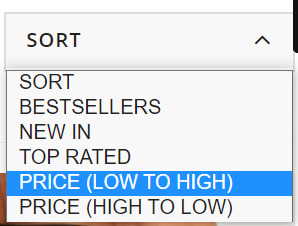
This makes sense since their purpose is to allow visitors to simply sort or narrow page content rather than offering alternative results and additional value (which is offered through faceted navigation). As such, filter typically produce duplicate results which should not be discoverable beyond the immediate moment. But this hard-and-fast rule doesn’t always apply perfectly in the real world. This is why we need to look at our individual industries and understand what’s important to our unique set of customers.
If we look at the world of gifting, we often see people shopping with a particular budget in mind. Therefore, terms like “birthday gift under £20” (40 m/s) or “Secret Santa gift under £10” (2.9k m/s) are reasonably common, and opening up relevant listing pages could be useful for shoppers.
Step 4: The technical steps
Facet taxonomies are hugely complex and the number of attributes that can be strung together increases with the size of the domain. We, therefore, need to carefully manage the flood gates and mitigate against any potential risks including crawl inefficiencies and link equity dilution.
We can do this by:
1. Avoiding thin/doorway pages by regularly re-assessing your product offering. For instance, you may consider there to be little value in creating a new listings page if you’re selling a very small range of low price point products. In this case, you may decide against opening up an additional Product Listing Page when you sell as few as 10 eligible products. However, this is not a fixed rule, so it’s quite possible that your criteria may be lower for particular product lines. Either way, these numbers will change over time. Consider seasonal trends, when new collections are launched, and when they become discontinued. Setting up a product retirement strategy to manage expired products and categories at scale in parallel with this step is also highly recommended.
2. Prevent content cannibalization by arranging selected facets according to their value and significance. “Size” is very important for some electrical goods like TVs, laptops, and cameras, but is less so for beauty accessories or vacuum cleaners. You must also make sure page content is distinctive and reflects the focus of your chosen facet(s). Refer to step 5 for more details.
3. Follow the sequence in which adjectives and facets are typically selected by your customers. This can vary depending on where your audience lives. So, whilst products generally have five or more distinguishable features, English vernacular determines that we use more than four adjectives (e.g. size + color + material + shape) to describe something.
4. Control the controllables by dealing with overlapping variations. This typically occurs when multiples co-exist and each exhibits good search metrics. For instance, it’s reasonable for someone to simultaneously look for several color and/or fabric combinations in the different ways below.

When this situation occurs, we should follow the same linguistic rules as above and choose a preferred sequence. In this case, it would be color + material + product type.
In comparison to the noindex tag suggested for on-page filters you should canonicalize unnecessary facets to their parent page (remembering that this is merely a hint and not a directive). This will enable you to control how crawlers deal with highly comparable result pages and will, therefore, help to prevent your site from being demoted in the SERPs. Dynamic search parameters should continue to be defined with a “noindex, nofollow” meta robots tag, disallowed in the robots.txt file, and configured through Google’s URL parameter tool (within your Search Console account) to tell crawlers the purpose of your parameters and how you would like them to be treated. This is a helpful guide on parameter handling for Googlebots, but bear in mind that this last tip won’t influence how Bing or Yahoo user-agents interpret these pages.
5. Open your facets in phases and cultivate it into a test-and-learn process. This will enable you to identify issues a lot sooner and implement facet-wide solutions in a timely manner. Without having to unravel these additional layers of complexity, problems such as crawl inefficiencies, PageRank dilution, or excessive indexation can be swiftly resolved.
To show you what this could look like, I’ve provided a phasing plan that was created for one of our e-commerce clients. Our research showed a significant SEO opportunity for opening up some of the facets and filters: potential +£263Kpcm for the “colour + type” facet (UK):
What’s more, when we extended our forecast to include other facet combinations, we calculated an additional revenue opportunity of up to +£207K/pcm (before filtering out combinations with no products offering).
Step 5: Optimize your facet URLs
Optimize your new facet category URLs to establish relevancy for your selected search terms. The key on-page elements to focus on include:
URL
Page title
Breadcrumb anchor texts
H tags
Content snippets (e.g. introductory text and FAQ copy)
Image ALT texts
Product names
Link out to similar facet category pages (i.e. via a “You May Also Like” feature box)
David’s Bridal is a good example of a retailer that has done this well. Looking back at the ‘Long Sleeve Wedding Dress’ Product Listing Page, we can see that they’ve curated unique content and followed fundamental optimization tactics on the landing page in a way that feels helpful to the user.
URL: davidsbridal.com/long-sleeve-wedding-dresses
Page Title: Long Sleeve Wedding Dresses & Gowns | David's Bridal
Meta Description: Do you dream of wearing a long sleeve wedding dress on your big day? Shop David's Bridal wide variety of wedding gowns with sleeves in lace & other designs!
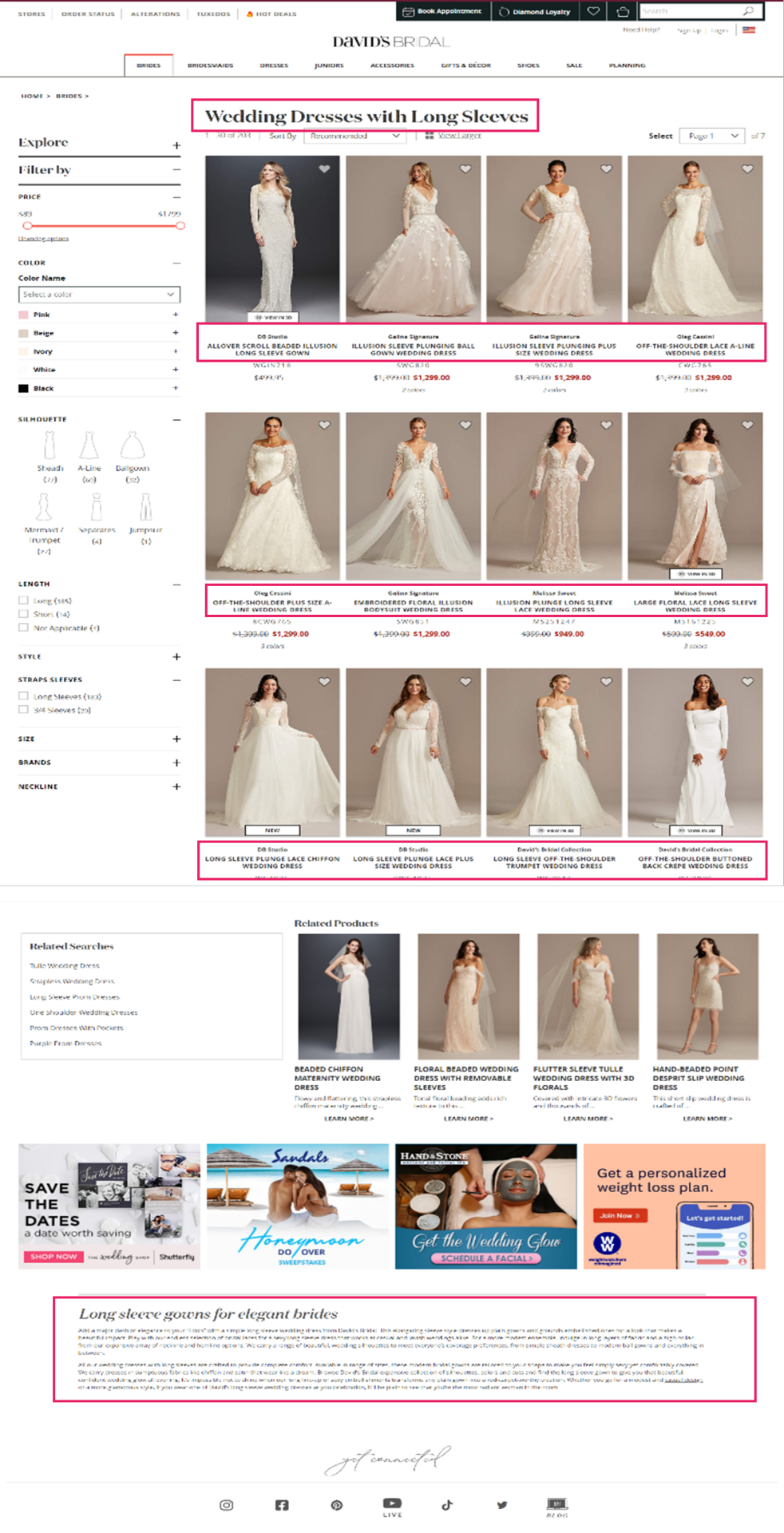
6. Provide accessibility and build page authority
Once you’ve opened up your new facet Product Listing Pages, you need to begin cultivating link equity towards them. This will ensure that they don’t exist as orphan URLs with no PageRank:
Ensure they’re referenced in your product XML sitemap.
If you have one feature per facet URL, then add them to your faceted navigation across CLP and Product Listing Page pages.
If you have two or more features per facet URL, then create a “Popular Searches” or “Related Searches” option within your CLPs.
Utilize your mega menu to showcase your new category landing pages. This will not only allow you to direct a large proportion of link equity, but it will also secure the highest click-through rate amongst your visitors.
Integrate your editorial strategy by creating engaging content with in-copy links. Think about how you can use descriptive long-tail anchor text about the Product Listing Page you want to link to rather than relying on “click here” or “see more”.
Connect to them via href links so you’re not solely relying on links from the main navigation or content hyperlinks. As this is difficult to do at scale, it can be done through modules such as “related categories”, “other subcategories”, “related products”, etc.
Devise strategic outreach campaigns that will secure quality, external backlinks to them.
Implementing this holistic and robust strategy will help you to secure exponential growth from your new commercial landing pages.
Conclusion
There is a great deal of organic opportunity that exists within your faceted navigation if you begin to leverage mid- and long-tail search terms.
Seek out the opportunity from extended keyword research and competitor analysis before deciding which variants fulfill consumer demands and deliver optimal organic sessions and onsite conversions. Configure a single faceted URL for each opportunity and open them up for crawl and indexation. Ensure PageRank is distributed to them (both internally and externally) and develop your landing page content in line with quality optimization practices. This approach will help you to avoid having crawl inefficiencies, over indexation, cannibalization, or having thin doorway pages. In turn, your website will be better suited to attract highly-targeted users and guide them down the purchase funnel.
Maximizing UX and reducing reliance on other marketing channels means that your faceted navigation can truly deliver organic ROI. We have seen this work for our clients.
0 notes
Text
Fulfill Untapped Customer Demands Through Your Faceted Navigation
Faceted navigation allows customers to narrow down search results based on specific product attributes. They typically exist on Product Listing Pages (PLPs) and are a great way to help users intuitively discover products but managing this filtering system is a common SEO challenge. Crawling and indexation need to be controlled.
However, if we look beyond their inherent functionality, facets can offer us considerable potential. By centering your secondary navigation on long-tail keyword opportunities, you’ll be able to strategically utilize consumer intent, secure additional web conversions, and boost revenue levels.
Match consumer intent with long-tail search queries
Having an established brand and a solid domain backlink profile won’t guarantee success. This is great news for smaller brands, as industry giants aren’t necessarily going to win at this game.
If we search for “long sleeve wedding dresses”, we can see how David’s Bridal’s optimized facet page (Domain Authority: 67/100, Page Authority: 47 / 100) has obtained the top ranking position, while Nordstrom’s result (Domain Authority: 87/100, Page Authority: 39/100) appears in the third position for this particular query. We’ll take a look at what makes this page so effective later.
When looking at how we can optimize faceted navigations, it’s important to recognize that product attributes convey consumer needs and aspirations. If, for example, I’m looking for a wedding dress, then I may tailor my search by the color, fabric, neckline shape, and the sleeve length.
According to the search demand curve, long-tail queries account for up to 70% of all organic searches. They are highly targeted queries that offer big traffic-driving opportunities.
In the last few years, we’ve seen a big shift in the industry towards capitalizing this intent with long-form content. Blog articles and style guides have become the go-to methods for many to capture these visitors, as we can see from the examples taken from Marks & Spencers’ "Inspire Me" section:
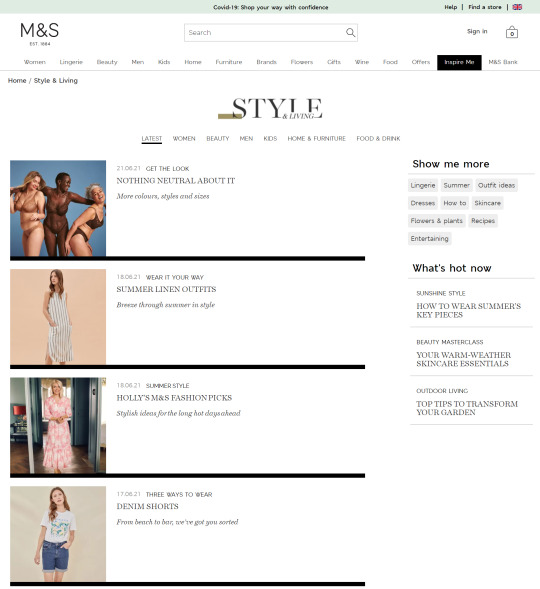
People often look for inspiration when they’re shopping, and these pages provide an effective way to add more internal links to category and product pages. But relying on this approach is one-dimensional, given that these deeper content pages tend to have lower PageRank. An extensive amount of time and effort will, therefore, be required to achieve the desired result.
In comparison, Product Listing Pages usually target broader search terms, and faceted navigations typically exist as passive functions. This is because they’re often blocked from crawlers, making them devoid of any SEO value. Waterstones (a well-known British bookstore) is one retailer that applies this rule for their on-page filters:
In this particular example, I’ve applied a filter to only show me books for 5 – 8 year olds, but the appended URL (https://www.waterstones.com/category/childrens-teenage/facet/498) is blocked in the robots.txt file. This is going to prevent such pages from being served in the SERPs despite them having the potential to meet specific customer needs. This shows that there can be a fundamental disconnect in matching customer intent to the pages we’re providing them in the organic results.
From the diagram below, we can see how editorial content typically focuses on the “awareness” and “interest” stages, whilst Product Listing Pages tend to be more in line with the “consideration” and “purchase” phases:
Serving the right content to users throughout their buying journey is pivotal to success. For many retailers, competitors are continuing to prioritize broader, high-volume keywords in saturated markets. They’re targeting the same terms to secure a proportion of the same search traffic. This is a very challenging prospect to face, and without carving out a gap in the marketplace, they won’t necessarily deliver the results they seek to secure. Likewise, relying on informational guides to target long-tail keywords means that you’re missing a large percentage of users who have very specific buying requirements. Yes, they’re ready to make a purchase!
By shifting your focus to address your customer’s real needs and expectations, you’ll be able to deliver a satisfying, frictionless experience at every interaction and all the way through to that final purchase.
The solution
Step 1: Conduct long-tail keyword research
Build a really comprehensive view of your potential customers by harnessing data from a variety of sources, including:
a) Keyword research tools like Moz, Google Keyword Planner, and Answer The Public.
b) The SERPs — get inspiration from the auto-suggest results, People Also Ask, and the related search links at the bottom of the page.
c) Competitor activity — aside from using SEO monitoring software, you can use a data mining extension tool like Scraper, which will extract faceted options directly from competitor Product Listing Pages. These tools are often free to download and allow you to quickly transfer product categories.
d) Your Google Search Console, Analytics, and PPC accounts to determine which keywords and URLs are securing the highest number of visits and web conversions. Internal search data can also give you great consumer insights.
e) Speak to your merchandising team to understand product demands and fulfillment capabilities.
Step 2: Group into meaningful sub-topics
Once you’ve collated all this information into a spreadsheet, you’ll be able to discover long-tail, consideration-orientated keywords. While individually they may not boast huge monthly search estimates, they can collectively highlight where purchase intentions can be better fulfilled.
To help illustrate this point, we can look at a small subset of lingerie keywords and the facets the searches represent:

From the table above we can quickly see a pattern emerging with color and material variations appearing across the search terms. We can then substantiate this information with session and revenue estimates with the use of a recognized CTR model. This enables us to help forecast the potential organic uplift and quantify the size of the prize for a number of different scenarios that are on offer from each new facet combination. This may include estimations for securing position 10, 7, 5, 3 and 1 in Google.
One thing to note here is that it’s worth excluding synonyms, as they will falsely inflate your calculations. An example here would be to exclude “storage drawers” (22.2k monthly searchers) when reviewing the performance for “chest of drawers” (201k m/s). Including both variants will cause a false positive result and will lead you to draw incorrect conclusions.
Step 3: Dig deeper into broader terms around offers, ratings, and price
These product filters are found in the “Sort” dropdown box and, from my experience, these are set to “noindex” from the outset as they simply allow users to re-order page results. Certainly, content management systems like Shopify and Shopware have this as a default.
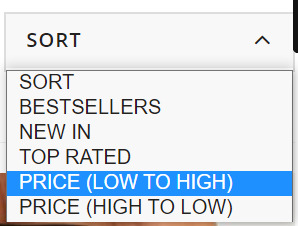
This makes sense since their purpose is to allow visitors to simply sort or narrow page content rather than offering alternative results and additional value (which is offered through faceted navigation). As such, filter typically produce duplicate results which should not be discoverable beyond the immediate moment. But this hard-and-fast rule doesn’t always apply perfectly in the real world. This is why we need to look at our individual industries and understand what’s important to our unique set of customers.
If we look at the world of gifting, we often see people shopping with a particular budget in mind. Therefore, terms like “birthday gift under £20” (40 m/s) or “Secret Santa gift under £10” (2.9k m/s) are reasonably common, and opening up relevant listing pages could be useful for shoppers.
Step 4: The technical steps
Facet taxonomies are hugely complex and the number of attributes that can be strung together increases with the size of the domain. We, therefore, need to carefully manage the flood gates and mitigate against any potential risks including crawl inefficiencies and link equity dilution.
We can do this by:
1. Avoiding thin/doorway pages by regularly re-assessing your product offering. For instance, you may consider there to be little value in creating a new listings page if you’re selling a very small range of low price point products. In this case, you may decide against opening up an additional Product Listing Page when you sell as few as 10 eligible products. However, this is not a fixed rule, so it’s quite possible that your criteria may be lower for particular product lines. Either way, these numbers will change over time. Consider seasonal trends, when new collections are launched, and when they become discontinued. Setting up a product retirement strategy to manage expired products and categories at scale in parallel with this step is also highly recommended.
2. Prevent content cannibalization by arranging selected facets according to their value and significance. “Size” is very important for some electrical goods like TVs, laptops, and cameras, but is less so for beauty accessories or vacuum cleaners. You must also make sure page content is distinctive and reflects the focus of your chosen facet(s). Refer to step 5 for more details.
3. Follow the sequence in which adjectives and facets are typically selected by your customers. This can vary depending on where your audience lives. So, whilst products generally have five or more distinguishable features, English vernacular determines that we use more than four adjectives (e.g. size + color + material + shape) to describe something.
4. Control the controllables by dealing with overlapping variations. This typically occurs when multiples co-exist and each exhibits good search metrics. For instance, it’s reasonable for someone to simultaneously look for several color and/or fabric combinations in the different ways below.

When this situation occurs, we should follow the same linguistic rules as above and choose a preferred sequence. In this case, it would be color + material + product type.
In comparison to the noindex tag suggested for on-page filters you should canonicalize unnecessary facets to their parent page (remembering that this is merely a hint and not a directive). This will enable you to control how crawlers deal with highly comparable result pages and will, therefore, help to prevent your site from being demoted in the SERPs. Dynamic search parameters should continue to be defined with a “noindex, nofollow” meta robots tag, disallowed in the robots.txt file, and configured through Google’s URL parameter tool (within your Search Console account) to tell crawlers the purpose of your parameters and how you would like them to be treated. This is a helpful guide on parameter handling for Googlebots, but bear in mind that this last tip won’t influence how Bing or Yahoo user-agents interpret these pages.
5. Open your facets in phases and cultivate it into a test-and-learn process. This will enable you to identify issues a lot sooner and implement facet-wide solutions in a timely manner. Without having to unravel these additional layers of complexity, problems such as crawl inefficiencies, PageRank dilution, or excessive indexation can be swiftly resolved.
To show you what this could look like, I’ve provided a phasing plan that was created for one of our e-commerce clients. Our research showed a significant SEO opportunity for opening up some of the facets and filters: potential +£263Kpcm for the “colour + type” facet (UK):
What’s more, when we extended our forecast to include other facet combinations, we calculated an additional revenue opportunity of up to +£207K/pcm (before filtering out combinations with no products offering).
Step 5: Optimize your facet URLs
Optimize your new facet category URLs to establish relevancy for your selected search terms. The key on-page elements to focus on include:
URL
Page title
Breadcrumb anchor texts
H tags
Content snippets (e.g. introductory text and FAQ copy)
Image ALT texts
Product names
Link out to similar facet category pages (i.e. via a “You May Also Like” feature box)
David’s Bridal is a good example of a retailer that has done this well. Looking back at the ‘Long Sleeve Wedding Dress’ Product Listing Page, we can see that they’ve curated unique content and followed fundamental optimization tactics on the landing page in a way that feels helpful to the user.
URL: davidsbridal.com/long-sleeve-wedding-dresses
Page Title: Long Sleeve Wedding Dresses & Gowns | David's Bridal
Meta Description: Do you dream of wearing a long sleeve wedding dress on your big day? Shop David's Bridal wide variety of wedding gowns with sleeves in lace & other designs!
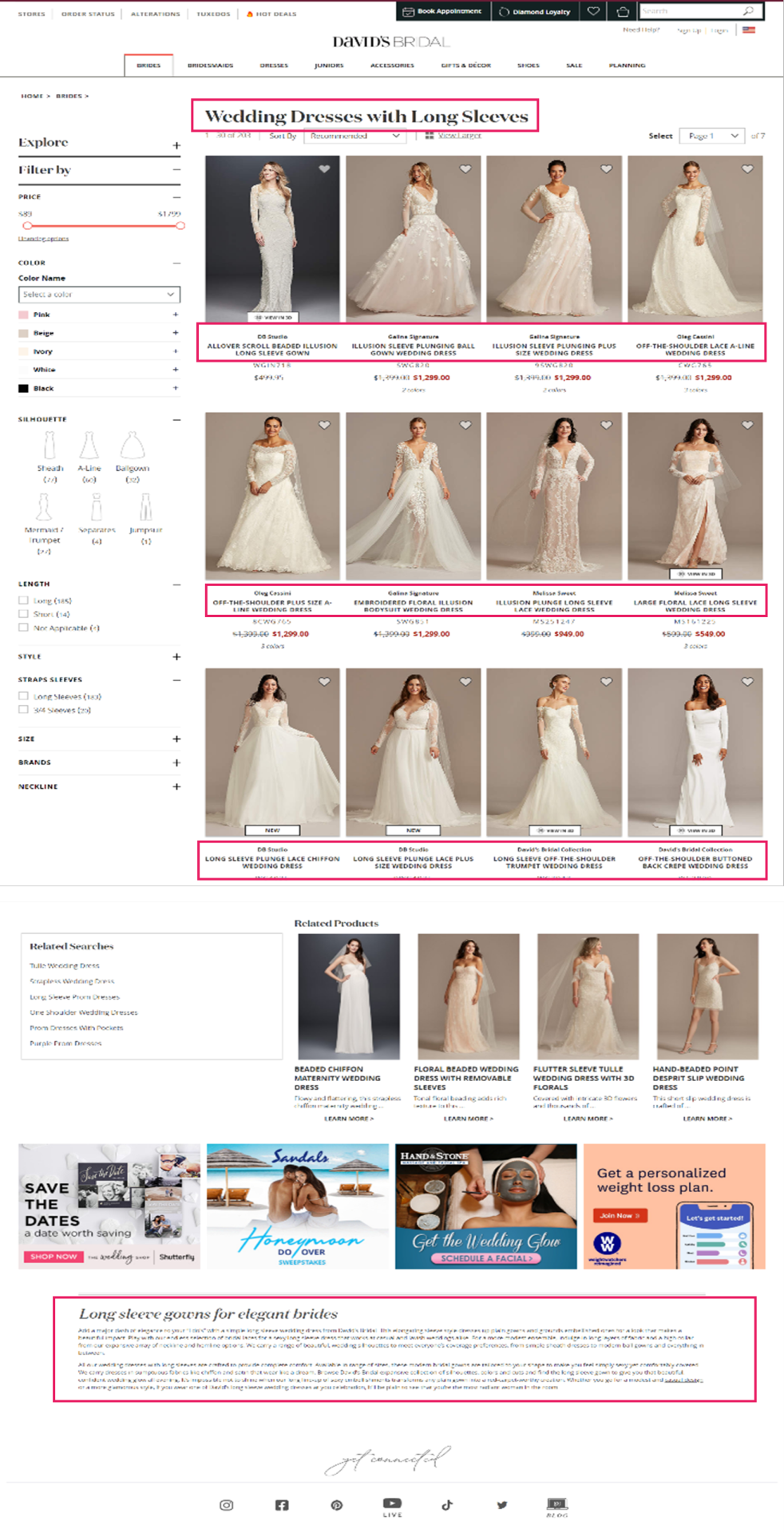
6. Provide accessibility and build page authority
Once you’ve opened up your new facet Product Listing Pages, you need to begin cultivating link equity towards them. This will ensure that they don’t exist as orphan URLs with no PageRank:
Ensure they’re referenced in your product XML sitemap.
If you have one feature per facet URL, then add them to your faceted navigation across CLP and Product Listing Page pages.
If you have two or more features per facet URL, then create a “Popular Searches” or “Related Searches” option within your CLPs.
Utilize your mega menu to showcase your new category landing pages. This will not only allow you to direct a large proportion of link equity, but it will also secure the highest click-through rate amongst your visitors.
Integrate your editorial strategy by creating engaging content with in-copy links. Think about how you can use descriptive long-tail anchor text about the Product Listing Page you want to link to rather than relying on “click here” or “see more”.
Connect to them via href links so you’re not solely relying on links from the main navigation or content hyperlinks. As this is difficult to do at scale, it can be done through modules such as “related categories”, “other subcategories”, “related products”, etc.
Devise strategic outreach campaigns that will secure quality, external backlinks to them.
Implementing this holistic and robust strategy will help you to secure exponential growth from your new commercial landing pages.
Conclusion
There is a great deal of organic opportunity that exists within your faceted navigation if you begin to leverage mid- and long-tail search terms.
Seek out the opportunity from extended keyword research and competitor analysis before deciding which variants fulfill consumer demands and deliver optimal organic sessions and onsite conversions. Configure a single faceted URL for each opportunity and open them up for crawl and indexation. Ensure PageRank is distributed to them (both internally and externally) and develop your landing page content in line with quality optimization practices. This approach will help you to avoid having crawl inefficiencies, over indexation, cannibalization, or having thin doorway pages. In turn, your website will be better suited to attract highly-targeted users and guide them down the purchase funnel.
Maximizing UX and reducing reliance on other marketing channels means that your faceted navigation can truly deliver organic ROI. We have seen this work for our clients.
0 notes
Text
Fulfill Untapped Customer Demands Through Your Faceted Navigation
Faceted navigation allows customers to narrow down search results based on specific product attributes. They typically exist on Product Listing Pages (PLPs) and are a great way to help users intuitively discover products but managing this filtering system is a common SEO challenge. Crawling and indexation need to be controlled.
However, if we look beyond their inherent functionality, facets can offer us considerable potential. By centering your secondary navigation on long-tail keyword opportunities, you’ll be able to strategically utilize consumer intent, secure additional web conversions, and boost revenue levels.
Match consumer intent with long-tail search queries
Having an established brand and a solid domain backlink profile won’t guarantee success. This is great news for smaller brands, as industry giants aren’t necessarily going to win at this game.
If we search for “long sleeve wedding dresses”, we can see how David’s Bridal’s optimized facet page (Domain Authority: 67/100, Page Authority: 47 / 100) has obtained the top ranking position, while Nordstrom’s result (Domain Authority: 87/100, Page Authority: 39/100) appears in the third position for this particular query. We’ll take a look at what makes this page so effective later.
When looking at how we can optimize faceted navigations, it’s important to recognize that product attributes convey consumer needs and aspirations. If, for example, I’m looking for a wedding dress, then I may tailor my search by the color, fabric, neckline shape, and the sleeve length.
According to the search demand curve, long-tail queries account for up to 70% of all organic searches. They are highly targeted queries that offer big traffic-driving opportunities.
In the last few years, we’ve seen a big shift in the industry towards capitalizing this intent with long-form content. Blog articles and style guides have become the go-to methods for many to capture these visitors, as we can see from the examples taken from Marks & Spencers’ "Inspire Me" section:

People often look for inspiration when they’re shopping, and these pages provide an effective way to add more internal links to category and product pages. But relying on this approach is one-dimensional, given that these deeper content pages tend to have lower PageRank. An extensive amount of time and effort will, therefore, be required to achieve the desired result.
In comparison, Product Listing Pages usually target broader search terms, and faceted navigations typically exist as passive functions. This is because they’re often blocked from crawlers, making them devoid of any SEO value. Waterstones (a well-known British bookstore) is one retailer that applies this rule for their on-page filters:
In this particular example, I’ve applied a filter to only show me books for 5 – 8 year olds, but the appended URL (https://ift.tt/3xrpOJS) is blocked in the robots.txt file. This is going to prevent such pages from being served in the SERPs despite them having the potential to meet specific customer needs. This shows that there can be a fundamental disconnect in matching customer intent to the pages we’re providing them in the organic results.
From the diagram below, we can see how editorial content typically focuses on the “awareness” and “interest” stages, whilst Product Listing Pages tend to be more in line with the “consideration” and “purchase” phases:
Serving the right content to users throughout their buying journey is pivotal to success. For many retailers, competitors are continuing to prioritize broader, high-volume keywords in saturated markets. They’re targeting the same terms to secure a proportion of the same search traffic. This is a very challenging prospect to face, and without carving out a gap in the marketplace, they won’t necessarily deliver the results they seek to secure. Likewise, relying on informational guides to target long-tail keywords means that you’re missing a large percentage of users who have very specific buying requirements. Yes, they’re ready to make a purchase!
By shifting your focus to address your customer’s real needs and expectations, you’ll be able to deliver a satisfying, frictionless experience at every interaction and all the way through to that final purchase.
The solution
Step 1: Conduct long-tail keyword research
Build a really comprehensive view of your potential customers by harnessing data from a variety of sources, including:
a) Keyword research tools like Moz, Google Keyword Planner, and Answer The Public.
b) The SERPs — get inspiration from the auto-suggest results, People Also Ask, and the related search links at the bottom of the page.
c) Competitor activity — aside from using SEO monitoring software, you can use a data mining extension tool like Scraper, which will extract faceted options directly from competitor Product Listing Pages. These tools are often free to download and allow you to quickly transfer product categories.
d) Your Google Search Console, Analytics, and PPC accounts to determine which keywords and URLs are securing the highest number of visits and web conversions. Internal search data can also give you great consumer insights.
e) Speak to your merchandising team to understand product demands and fulfillment capabilities.
Step 2: Group into meaningful sub-topics
Once you’ve collated all this information into a spreadsheet, you’ll be able to discover long-tail, consideration-orientated keywords. While individually they may not boast huge monthly search estimates, they can collectively highlight where purchase intentions can be better fulfilled.
To help illustrate this point, we can look at a small subset of lingerie keywords and the facets the searches represent:

From the table above we can quickly see a pattern emerging with color and material variations appearing across the search terms. We can then substantiate this information with session and revenue estimates with the use of a recognized CTR model. This enables us to help forecast the potential organic uplift and quantify the size of the prize for a number of different scenarios that are on offer from each new facet combination. This may include estimations for securing position 10, 7, 5, 3 and 1 in Google.
One thing to note here is that it’s worth excluding synonyms, as they will falsely inflate your calculations. An example here would be to exclude “storage drawers” (22.2k monthly searchers) when reviewing the performance for “chest of drawers” (201k m/s). Including both variants will cause a false positive result and will lead you to draw incorrect conclusions.
Step 3: Dig deeper into broader terms around offers, ratings, and price
These product filters are found in the “Sort” dropdown box and, from my experience, these are set to “noindex” from the outset as they simply allow users to re-order page results. Certainly, content management systems like Shopify and Shopware have this as a default.

This makes sense since their purpose is to allow visitors to simply sort or narrow page content rather than offering alternative results and additional value (which is offered through faceted navigation). As such, filter typically produce duplicate results which should not be discoverable beyond the immediate moment. But this hard-and-fast rule doesn’t always apply perfectly in the real world. This is why we need to look at our individual industries and understand what’s important to our unique set of customers.
If we look at the world of gifting, we often see people shopping with a particular budget in mind. Therefore, terms like “birthday gift under £20” (40 m/s) or “Secret Santa gift under £10” (2.9k m/s) are reasonably common, and opening up relevant listing pages could be useful for shoppers.
Step 4: The technical steps
Facet taxonomies are hugely complex and the number of attributes that can be strung together increases with the size of the domain. We, therefore, need to carefully manage the flood gates and mitigate against any potential risks including crawl inefficiencies and link equity dilution.
We can do this by:
1. Avoiding thin/doorway pages by regularly re-assessing your product offering. For instance, you may consider there to be little value in creating a new listings page if you’re selling a very small range of low price point products. In this case, you may decide against opening up an additional Product Listing Page when you sell as few as 10 eligible products. However, this is not a fixed rule, so it’s quite possible that your criteria may be lower for particular product lines. Either way, these numbers will change over time. Consider seasonal trends, when new collections are launched, and when they become discontinued. Setting up a product retirement strategy to manage expired products and categories at scale in parallel with this step is also highly recommended.
2. Prevent content cannibalization by arranging selected facets according to their value and significance. “Size” is very important for some electrical goods like TVs, laptops, and cameras, but is less so for beauty accessories or vacuum cleaners. You must also make sure page content is distinctive and reflects the focus of your chosen facet(s). Refer to step 5 for more details.
3. Follow the sequence in which adjectives and facets are typically selected by your customers. This can vary depending on where your audience lives. So, whilst products generally have five or more distinguishable features, English vernacular determines that we use more than four adjectives (e.g. size + color + material + shape) to describe something.
4. Control the controllables by dealing with overlapping variations. This typically occurs when multiples co-exist and each exhibits good search metrics. For instance, it’s reasonable for someone to simultaneously look for several color and/or fabric combinations in the different ways below.

When this situation occurs, we should follow the same linguistic rules as above and choose a preferred sequence. In this case, it would be color + material + product type.
In comparison to the noindex tag suggested for on-page filters you should canonicalize unnecessary facets to their parent page (remembering that this is merely a hint and not a directive). This will enable you to control how crawlers deal with highly comparable result pages and will, therefore, help to prevent your site from being demoted in the SERPs. Dynamic search parameters should continue to be defined with a “noindex, nofollow” meta robots tag, disallowed in the robots.txt file, and configured through Google’s URL parameter tool (within your Search Console account) to tell crawlers the purpose of your parameters and how you would like them to be treated. This is a helpful guide on parameter handling for Googlebots, but bear in mind that this last tip won’t influence how Bing or Yahoo user-agents interpret these pages.
5. Open your facets in phases and cultivate it into a test-and-learn process. This will enable you to identify issues a lot sooner and implement facet-wide solutions in a timely manner. Without having to unravel these additional layers of complexity, problems such as crawl inefficiencies, PageRank dilution, or excessive indexation can be swiftly resolved.
To show you what this could look like, I’ve provided a phasing plan that was created for one of our e-commerce clients. Our research showed a significant SEO opportunity for opening up some of the facets and filters: potential +£263Kpcm for the “colour + type” facet (UK):
What’s more, when we extended our forecast to include other facet combinations, we calculated an additional revenue opportunity of up to +£207K/pcm (before filtering out combinations with no products offering).
Step 5: Optimize your facet URLs
Optimize your new facet category URLs to establish relevancy for your selected search terms. The key on-page elements to focus on include:
URL
Page title
Breadcrumb anchor texts
H tags
Content snippets (e.g. introductory text and FAQ copy)
Image ALT texts
Product names
Link out to similar facet category pages (i.e. via a “You May Also Like” feature box)
David’s Bridal is a good example of a retailer that has done this well. Looking back at the ‘Long Sleeve Wedding Dress’ Product Listing Page, we can see that they’ve curated unique content and followed fundamental optimization tactics on the landing page in a way that feels helpful to the user.
URL: davidsbridal.com/long-sleeve-wedding-dresses
Page Title: Long Sleeve Wedding Dresses & Gowns | David's Bridal
Meta Description: Do you dream of wearing a long sleeve wedding dress on your big day? Shop David's Bridal wide variety of wedding gowns with sleeves in lace & other designs!
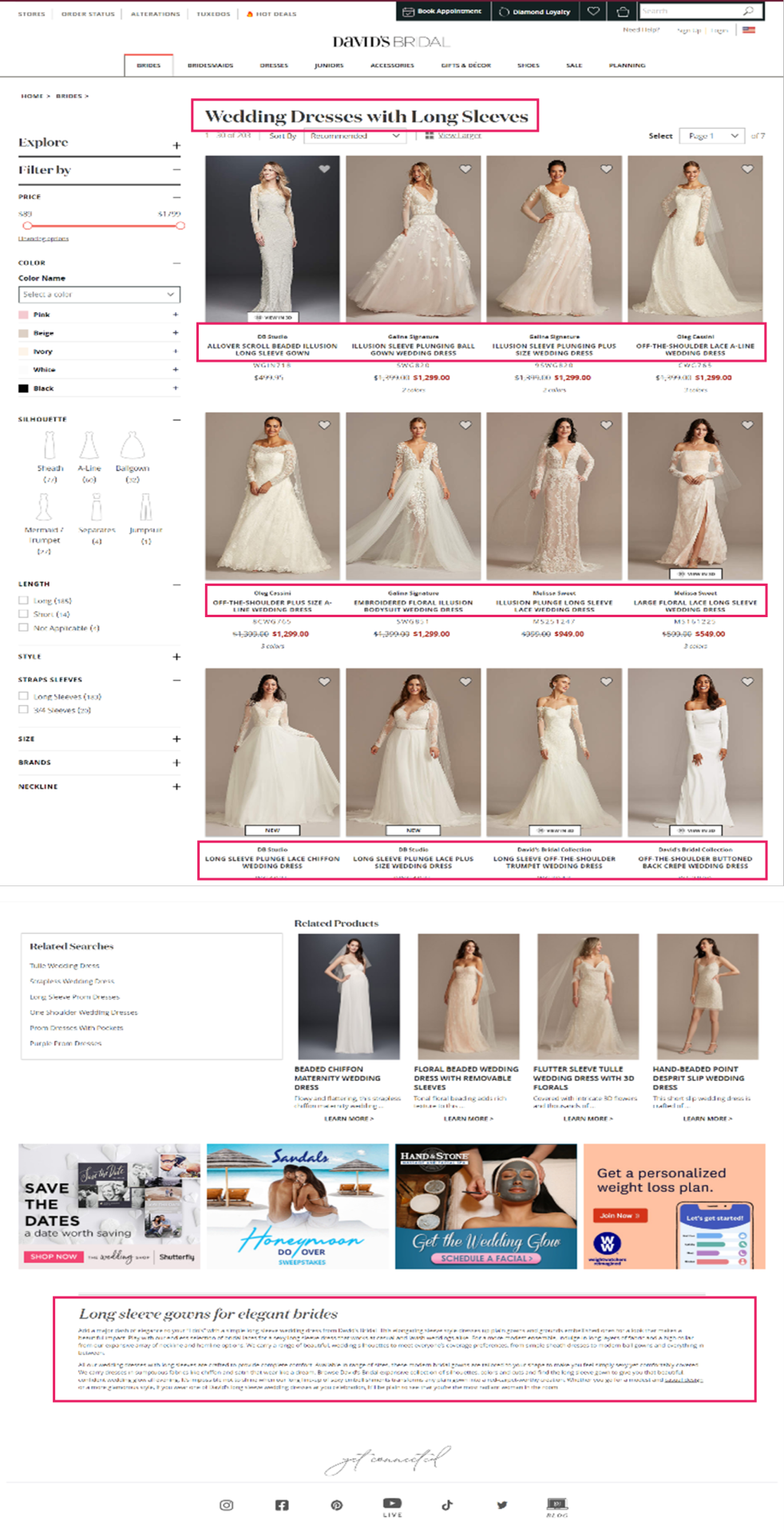
6. Provide accessibility and build page authority
Once you’ve opened up your new facet Product Listing Pages, you need to begin cultivating link equity towards them. This will ensure that they don’t exist as orphan URLs with no PageRank:
Ensure they’re referenced in your product XML sitemap.
If you have one feature per facet URL, then add them to your faceted navigation across CLP and Product Listing Page pages.
If you have two or more features per facet URL, then create a “Popular Searches” or “Related Searches” option within your CLPs.
Utilize your mega menu to showcase your new category landing pages. This will not only allow you to direct a large proportion of link equity, but it will also secure the highest click-through rate amongst your visitors.
Integrate your editorial strategy by creating engaging content with in-copy links. Think about how you can use descriptive long-tail anchor text about the Product Listing Page you want to link to rather than relying on “click here” or “see more”.
Connect to them via href links so you’re not solely relying on links from the main navigation or content hyperlinks. As this is difficult to do at scale, it can be done through modules such as “related categories”, “other subcategories”, “related products”, etc.
Devise strategic outreach campaigns that will secure quality, external backlinks to them.
Implementing this holistic and robust strategy will help you to secure exponential growth from your new commercial landing pages.
Conclusion
There is a great deal of organic opportunity that exists within your faceted navigation if you begin to leverage mid- and long-tail search terms.
Seek out the opportunity from extended keyword research and competitor analysis before deciding which variants fulfill consumer demands and deliver optimal organic sessions and onsite conversions. Configure a single faceted URL for each opportunity and open them up for crawl and indexation. Ensure PageRank is distributed to them (both internally and externally) and develop your landing page content in line with quality optimization practices. This approach will help you to avoid having crawl inefficiencies, over indexation, cannibalization, or having thin doorway pages. In turn, your website will be better suited to attract highly-targeted users and guide them down the purchase funnel.
Maximizing UX and reducing reliance on other marketing channels means that your faceted navigation can truly deliver organic ROI. We have seen this work for our clients.
0 notes
Text
Fulfill Untapped Customer Demands Through Your Faceted Navigation
Faceted navigation allows customers to narrow down search results based on specific product attributes. They typically exist on Product Listing Pages (PLPs) and are a great way to help users intuitively discover products but managing this filtering system is a common SEO challenge. Crawling and indexation need to be controlled.
However, if we look beyond their inherent functionality, facets can offer us considerable potential. By centering your secondary navigation on long-tail keyword opportunities, you’ll be able to strategically utilize consumer intent, secure additional web conversions, and boost revenue levels.
Match consumer intent with long-tail search queries
Having an established brand and a solid domain backlink profile won’t guarantee success. This is great news for smaller brands, as industry giants aren’t necessarily going to win at this game.
If we search for “long sleeve wedding dresses”, we can see how David’s Bridal’s optimized facet page (Domain Authority: 67/100, Page Authority: 47 / 100) has obtained the top ranking position, while Nordstrom’s result (Domain Authority: 87/100, Page Authority: 39/100) appears in the third position for this particular query. We’ll take a look at what makes this page so effective later.
When looking at how we can optimize faceted navigations, it’s important to recognize that product attributes convey consumer needs and aspirations. If, for example, I’m looking for a wedding dress, then I may tailor my search by the color, fabric, neckline shape, and the sleeve length.
According to the search demand curve, long-tail queries account for up to 70% of all organic searches. They are highly targeted queries that offer big traffic-driving opportunities.
In the last few years, we’ve seen a big shift in the industry towards capitalizing this intent with long-form content. Blog articles and style guides have become the go-to methods for many to capture these visitors, as we can see from the examples taken from Marks & Spencers’ "Inspire Me" section:

People often look for inspiration when they’re shopping, and these pages provide an effective way to add more internal links to category and product pages. But relying on this approach is one-dimensional, given that these deeper content pages tend to have lower PageRank. An extensive amount of time and effort will, therefore, be required to achieve the desired result.
In comparison, Product Listing Pages usually target broader search terms, and faceted navigations typically exist as passive functions. This is because they’re often blocked from crawlers, making them devoid of any SEO value. Waterstones (a well-known British bookstore) is one retailer that applies this rule for their on-page filters:
In this particular example, I’ve applied a filter to only show me books for 5 – 8 year olds, but the appended URL (https://ift.tt/3xrpOJS) is blocked in the robots.txt file. This is going to prevent such pages from being served in the SERPs despite them having the potential to meet specific customer needs. This shows that there can be a fundamental disconnect in matching customer intent to the pages we’re providing them in the organic results.
From the diagram below, we can see how editorial content typically focuses on the “awareness” and “interest” stages, whilst Product Listing Pages tend to be more in line with the “consideration” and “purchase” phases:
Serving the right content to users throughout their buying journey is pivotal to success. For many retailers, competitors are continuing to prioritize broader, high-volume keywords in saturated markets. They’re targeting the same terms to secure a proportion of the same search traffic. This is a very challenging prospect to face, and without carving out a gap in the marketplace, they won’t necessarily deliver the results they seek to secure. Likewise, relying on informational guides to target long-tail keywords means that you’re missing a large percentage of users who have very specific buying requirements. Yes, they’re ready to make a purchase!
By shifting your focus to address your customer’s real needs and expectations, you’ll be able to deliver a satisfying, frictionless experience at every interaction and all the way through to that final purchase.
The solution
Step 1: Conduct long-tail keyword research
Build a really comprehensive view of your potential customers by harnessing data from a variety of sources, including:
a) Keyword research tools like Moz, Google Keyword Planner, and Answer The Public.
b) The SERPs — get inspiration from the auto-suggest results, People Also Ask, and the related search links at the bottom of the page.
c) Competitor activity — aside from using SEO monitoring software, you can use a data mining extension tool like Scraper, which will extract faceted options directly from competitor Product Listing Pages. These tools are often free to download and allow you to quickly transfer product categories.
d) Your Google Search Console, Analytics, and PPC accounts to determine which keywords and URLs are securing the highest number of visits and web conversions. Internal search data can also give you great consumer insights.
e) Speak to your merchandising team to understand product demands and fulfillment capabilities.
Step 2: Group into meaningful sub-topics
Once you’ve collated all this information into a spreadsheet, you’ll be able to discover long-tail, consideration-orientated keywords. While individually they may not boast huge monthly search estimates, they can collectively highlight where purchase intentions can be better fulfilled.
To help illustrate this point, we can look at a small subset of lingerie keywords and the facets the searches represent:
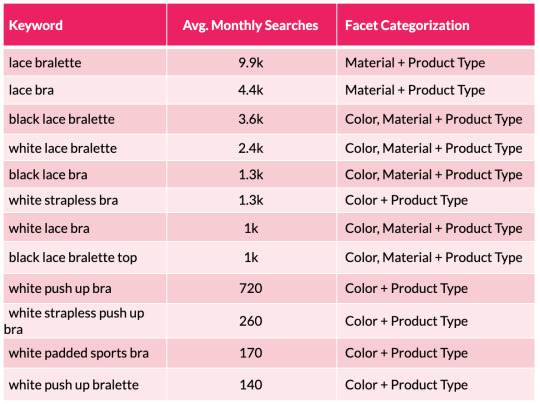
From the table above we can quickly see a pattern emerging with color and material variations appearing across the search terms. We can then substantiate this information with session and revenue estimates with the use of a recognized CTR model. This enables us to help forecast the potential organic uplift and quantify the size of the prize for a number of different scenarios that are on offer from each new facet combination. This may include estimations for securing position 10, 7, 5, 3 and 1 in Google.
One thing to note here is that it’s worth excluding synonyms, as they will falsely inflate your calculations. An example here would be to exclude “storage drawers” (22.2k monthly searchers) when reviewing the performance for “chest of drawers” (201k m/s). Including both variants will cause a false positive result and will lead you to draw incorrect conclusions.
Step 3: Dig deeper into broader terms around offers, ratings, and price
These product filters are found in the “Sort” dropdown box and, from my experience, these are set to “noindex” from the outset as they simply allow users to re-order page results. Certainly, content management systems like Shopify and Shopware have this as a default.

This makes sense since their purpose is to allow visitors to simply sort or narrow page content rather than offering alternative results and additional value (which is offered through faceted navigation). As such, filter typically produce duplicate results which should not be discoverable beyond the immediate moment. But this hard-and-fast rule doesn’t always apply perfectly in the real world. This is why we need to look at our individual industries and understand what’s important to our unique set of customers.
If we look at the world of gifting, we often see people shopping with a particular budget in mind. Therefore, terms like “birthday gift under £20” (40 m/s) or “Secret Santa gift under £10” (2.9k m/s) are reasonably common, and opening up relevant listing pages could be useful for shoppers.
Step 4: The technical steps
Facet taxonomies are hugely complex and the number of attributes that can be strung together increases with the size of the domain. We, therefore, need to carefully manage the flood gates and mitigate against any potential risks including crawl inefficiencies and link equity dilution.
We can do this by:
1. Avoiding thin/doorway pages by regularly re-assessing your product offering. For instance, you may consider there to be little value in creating a new listings page if you’re selling a very small range of low price point products. In this case, you may decide against opening up an additional Product Listing Page when you sell as few as 10 eligible products. However, this is not a fixed rule, so it’s quite possible that your criteria may be lower for particular product lines. Either way, these numbers will change over time. Consider seasonal trends, when new collections are launched, and when they become discontinued. Setting up a product retirement strategy to manage expired products and categories at scale in parallel with this step is also highly recommended.
2. Prevent content cannibalization by arranging selected facets according to their value and significance. “Size” is very important for some electrical goods like TVs, laptops, and cameras, but is less so for beauty accessories or vacuum cleaners. You must also make sure page content is distinctive and reflects the focus of your chosen facet(s). Refer to step 5 for more details.
3. Follow the sequence in which adjectives and facets are typically selected by your customers. This can vary depending on where your audience lives. So, whilst products generally have five or more distinguishable features, English vernacular determines that we use more than four adjectives (e.g. size + color + material + shape) to describe something.
4. Control the controllables by dealing with overlapping variations. This typically occurs when multiples co-exist and each exhibits good search metrics. For instance, it’s reasonable for someone to simultaneously look for several color and/or fabric combinations in the different ways below.
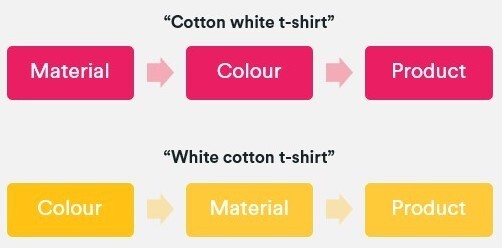
When this situation occurs, we should follow the same linguistic rules as above and choose a preferred sequence. In this case, it would be color + material + product type.
In comparison to the noindex tag suggested for on-page filters you should canonicalize unnecessary facets to their parent page (remembering that this is merely a hint and not a directive). This will enable you to control how crawlers deal with highly comparable result pages and will, therefore, help to prevent your site from being demoted in the SERPs. Dynamic search parameters should continue to be defined with a “noindex, nofollow” meta robots tag, disallowed in the robots.txt file, and configured through Google’s URL parameter tool (within your Search Console account) to tell crawlers the purpose of your parameters and how you would like them to be treated. This is a helpful guide on parameter handling for Googlebots, but bear in mind that this last tip won’t influence how Bing or Yahoo user-agents interpret these pages.
5. Open your facets in phases and cultivate it into a test-and-learn process. This will enable you to identify issues a lot sooner and implement facet-wide solutions in a timely manner. Without having to unravel these additional layers of complexity, problems such as crawl inefficiencies, PageRank dilution, or excessive indexation can be swiftly resolved.
To show you what this could look like, I’ve provided a phasing plan that was created for one of our e-commerce clients. Our research showed a significant SEO opportunity for opening up some of the facets and filters: potential +£263Kpcm for the “colour + type” facet (UK):
What’s more, when we extended our forecast to include other facet combinations, we calculated an additional revenue opportunity of up to +£207K/pcm (before filtering out combinations with no products offering).
Step 5: Optimize your facet URLs
Optimize your new facet category URLs to establish relevancy for your selected search terms. The key on-page elements to focus on include:
URL
Page title
Breadcrumb anchor texts
H tags
Content snippets (e.g. introductory text and FAQ copy)
Image ALT texts
Product names
Link out to similar facet category pages (i.e. via a “You May Also Like” feature box)
David’s Bridal is a good example of a retailer that has done this well. Looking back at the ‘Long Sleeve Wedding Dress’ Product Listing Page, we can see that they’ve curated unique content and followed fundamental optimization tactics on the landing page in a way that feels helpful to the user.
URL: davidsbridal.com/long-sleeve-wedding-dresses
Page Title: Long Sleeve Wedding Dresses & Gowns | David's Bridal
Meta Description: Do you dream of wearing a long sleeve wedding dress on your big day? Shop David's Bridal wide variety of wedding gowns with sleeves in lace & other designs!

6. Provide accessibility and build page authority
Once you’ve opened up your new facet Product Listing Pages, you need to begin cultivating link equity towards them. This will ensure that they don’t exist as orphan URLs with no PageRank:
Ensure they’re referenced in your product XML sitemap.
If you have one feature per facet URL, then add them to your faceted navigation across CLP and Product Listing Page pages.
If you have two or more features per facet URL, then create a “Popular Searches” or “Related Searches” option within your CLPs.
Utilize your mega menu to showcase your new category landing pages. This will not only allow you to direct a large proportion of link equity, but it will also secure the highest click-through rate amongst your visitors.
Integrate your editorial strategy by creating engaging content with in-copy links. Think about how you can use descriptive long-tail anchor text about the Product Listing Page you want to link to rather than relying on “click here” or “see more”.
Connect to them via href links so you’re not solely relying on links from the main navigation or content hyperlinks. As this is difficult to do at scale, it can be done through modules such as “related categories”, “other subcategories”, “related products”, etc.
Devise strategic outreach campaigns that will secure quality, external backlinks to them.
Implementing this holistic and robust strategy will help you to secure exponential growth from your new commercial landing pages.
Conclusion
There is a great deal of organic opportunity that exists within your faceted navigation if you begin to leverage mid- and long-tail search terms.
Seek out the opportunity from extended keyword research and competitor analysis before deciding which variants fulfill consumer demands and deliver optimal organic sessions and onsite conversions. Configure a single faceted URL for each opportunity and open them up for crawl and indexation. Ensure PageRank is distributed to them (both internally and externally) and develop your landing page content in line with quality optimization practices. This approach will help you to avoid having crawl inefficiencies, over indexation, cannibalization, or having thin doorway pages. In turn, your website will be better suited to attract highly-targeted users and guide them down the purchase funnel.
Maximizing UX and reducing reliance on other marketing channels means that your faceted navigation can truly deliver organic ROI. We have seen this work for our clients.
0 notes